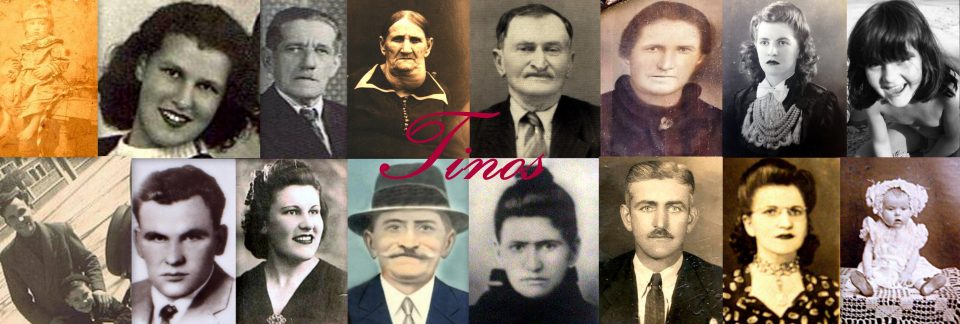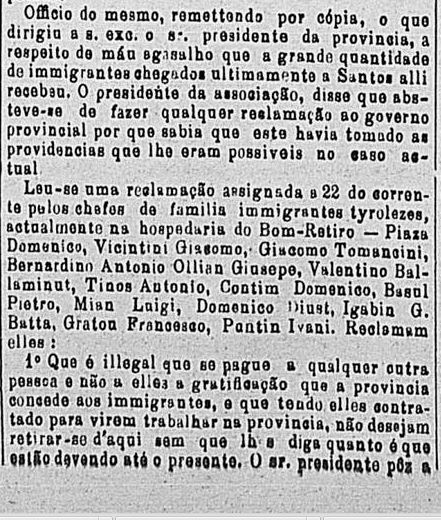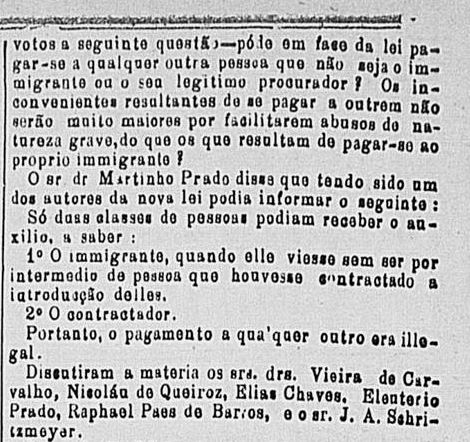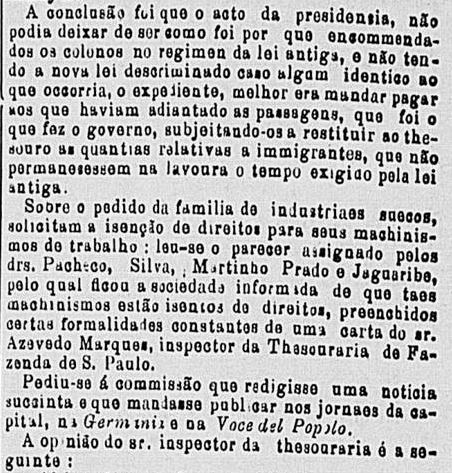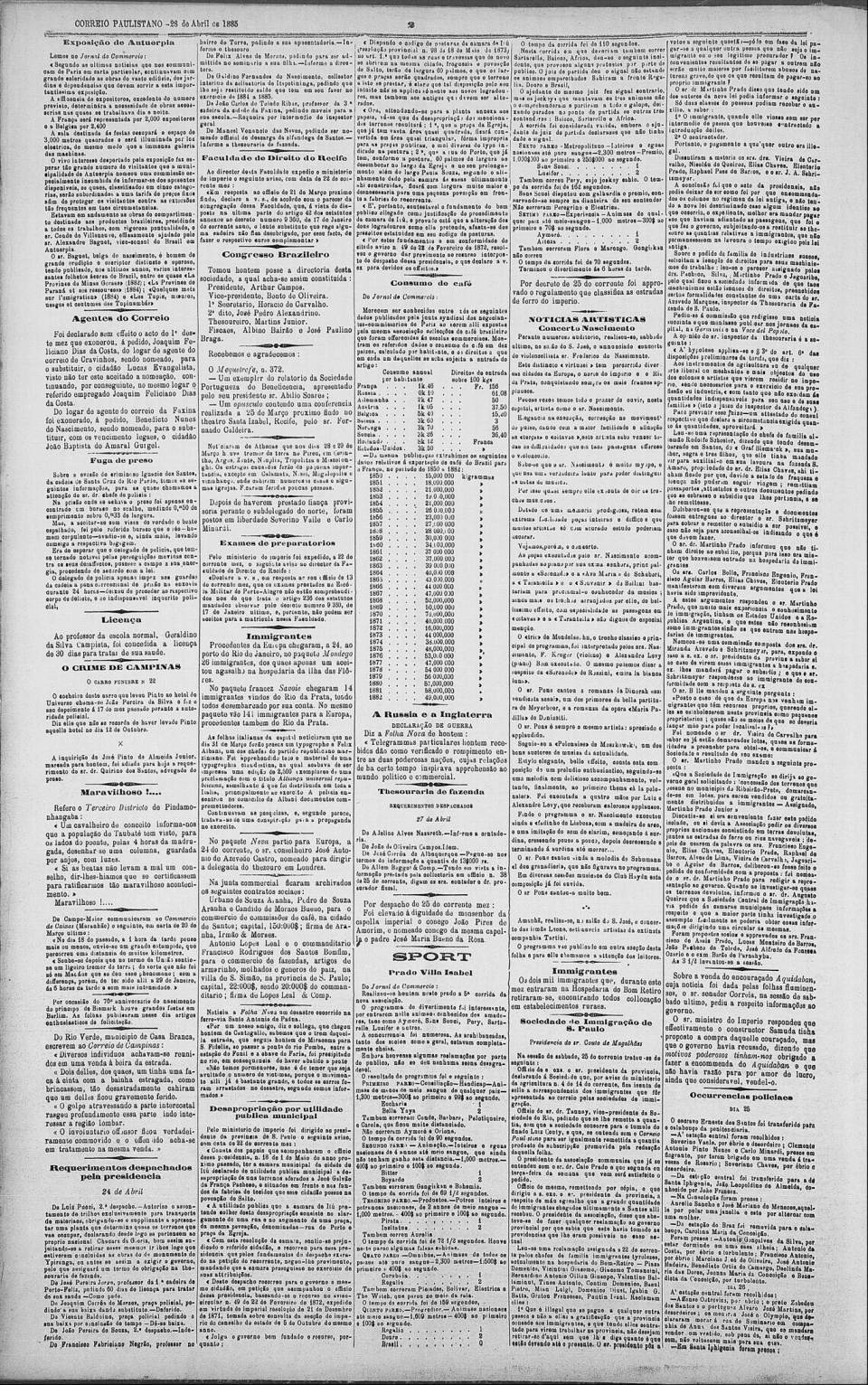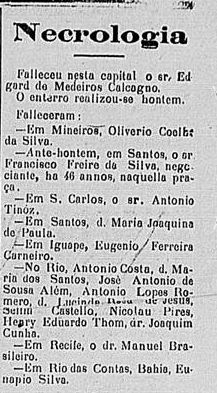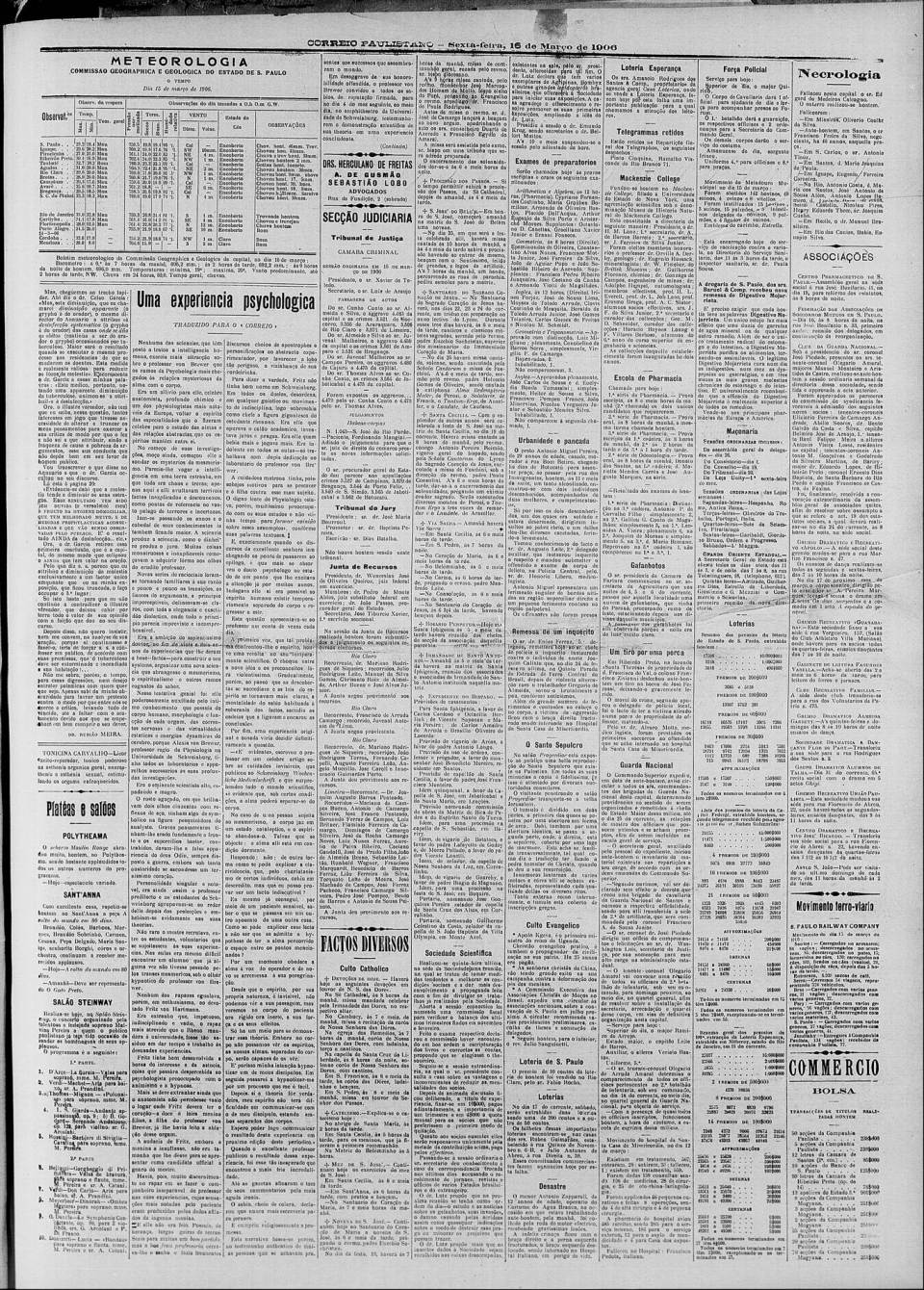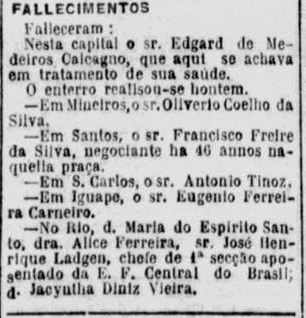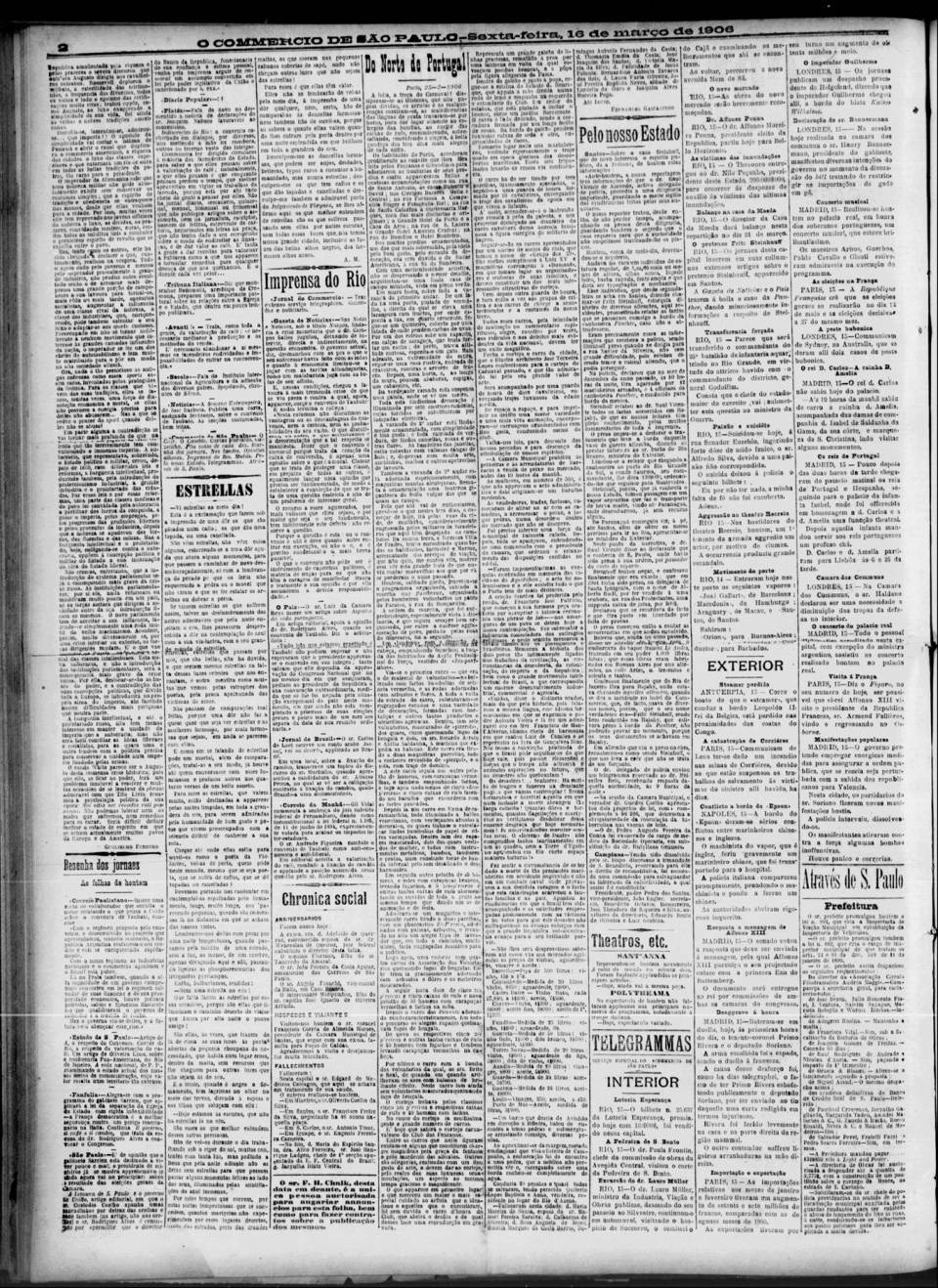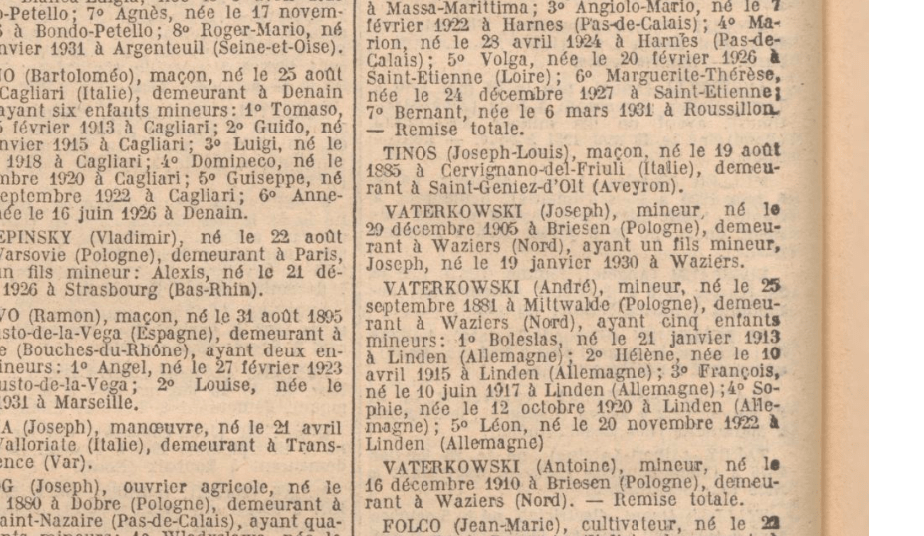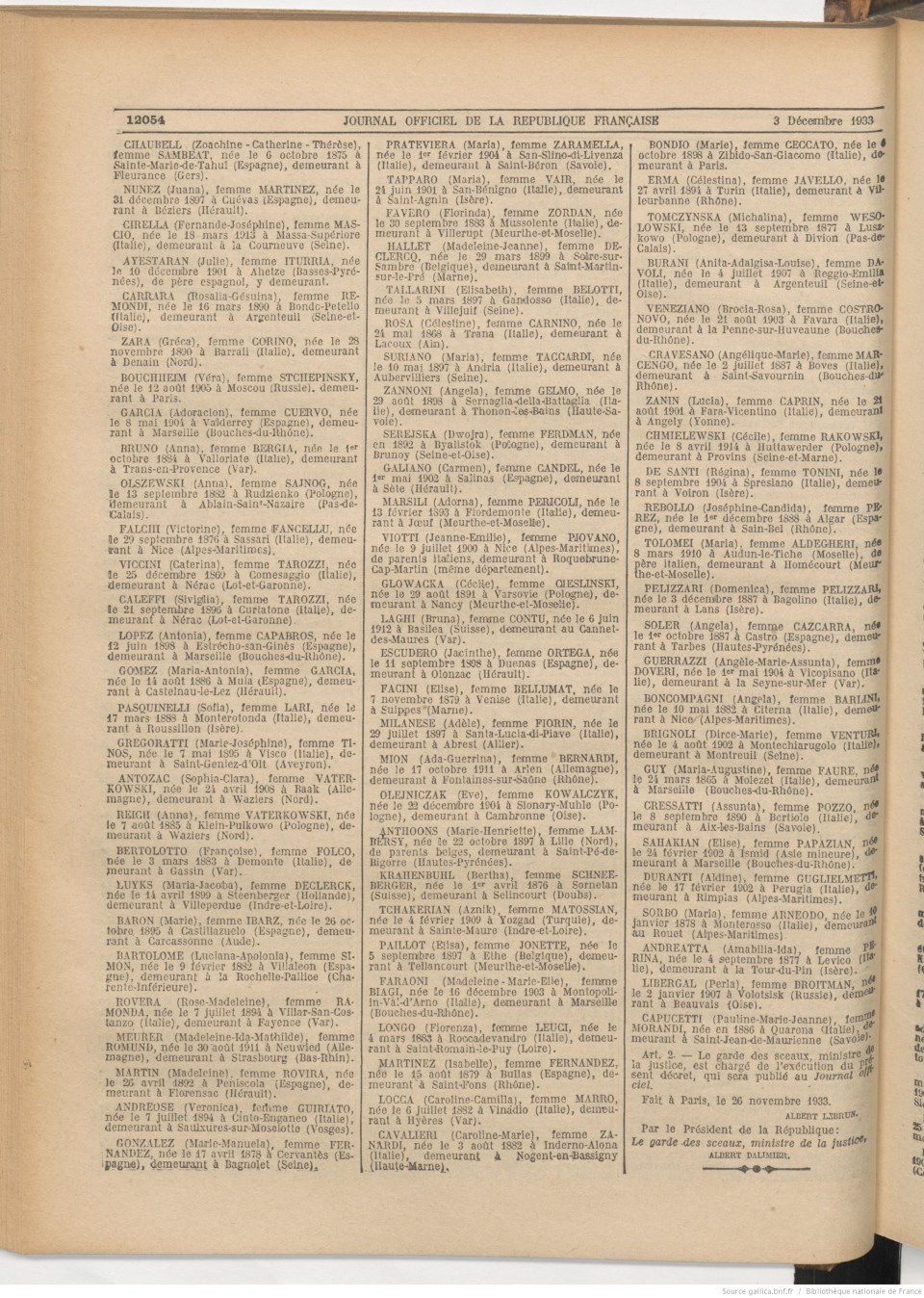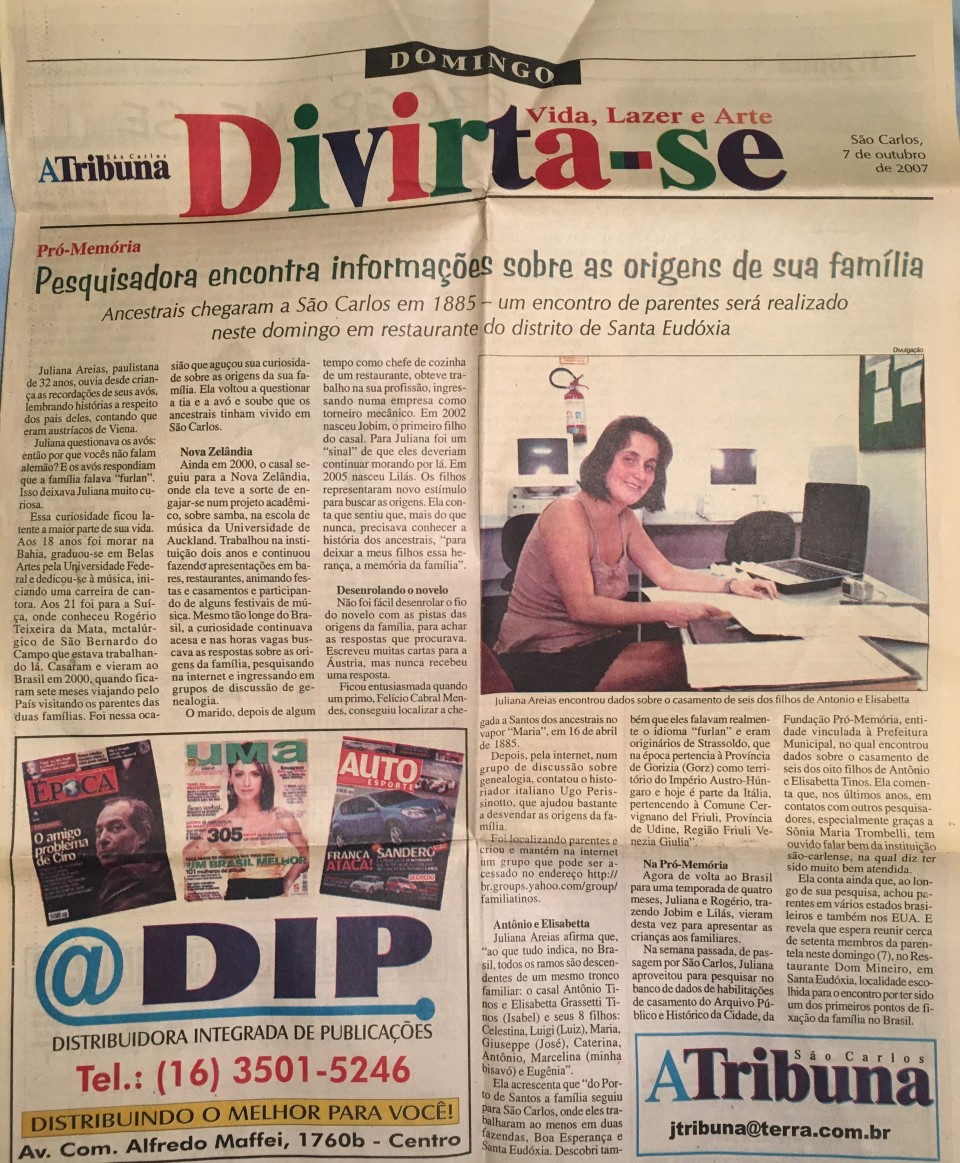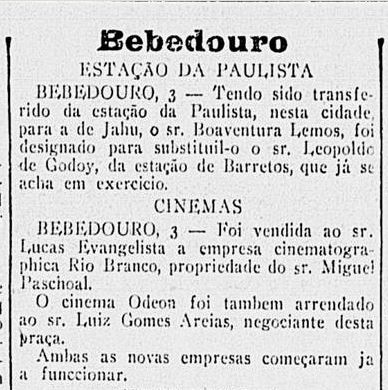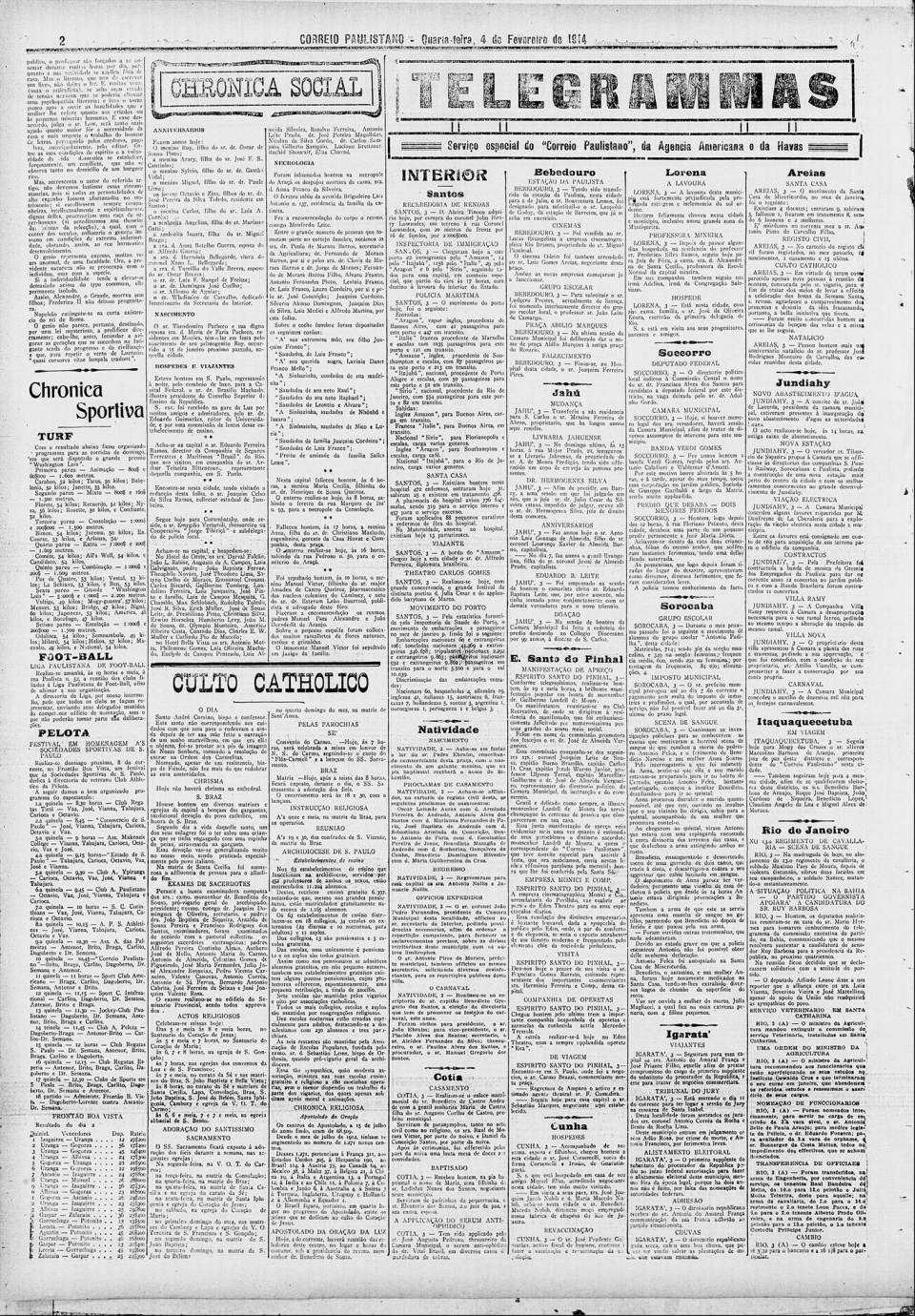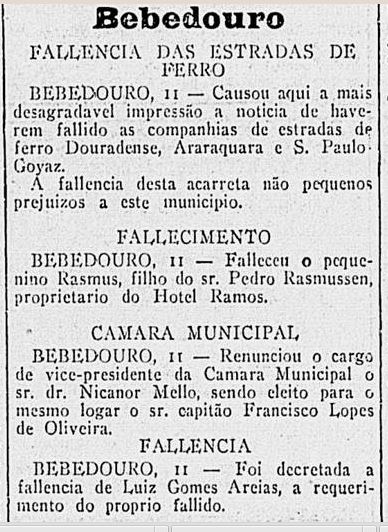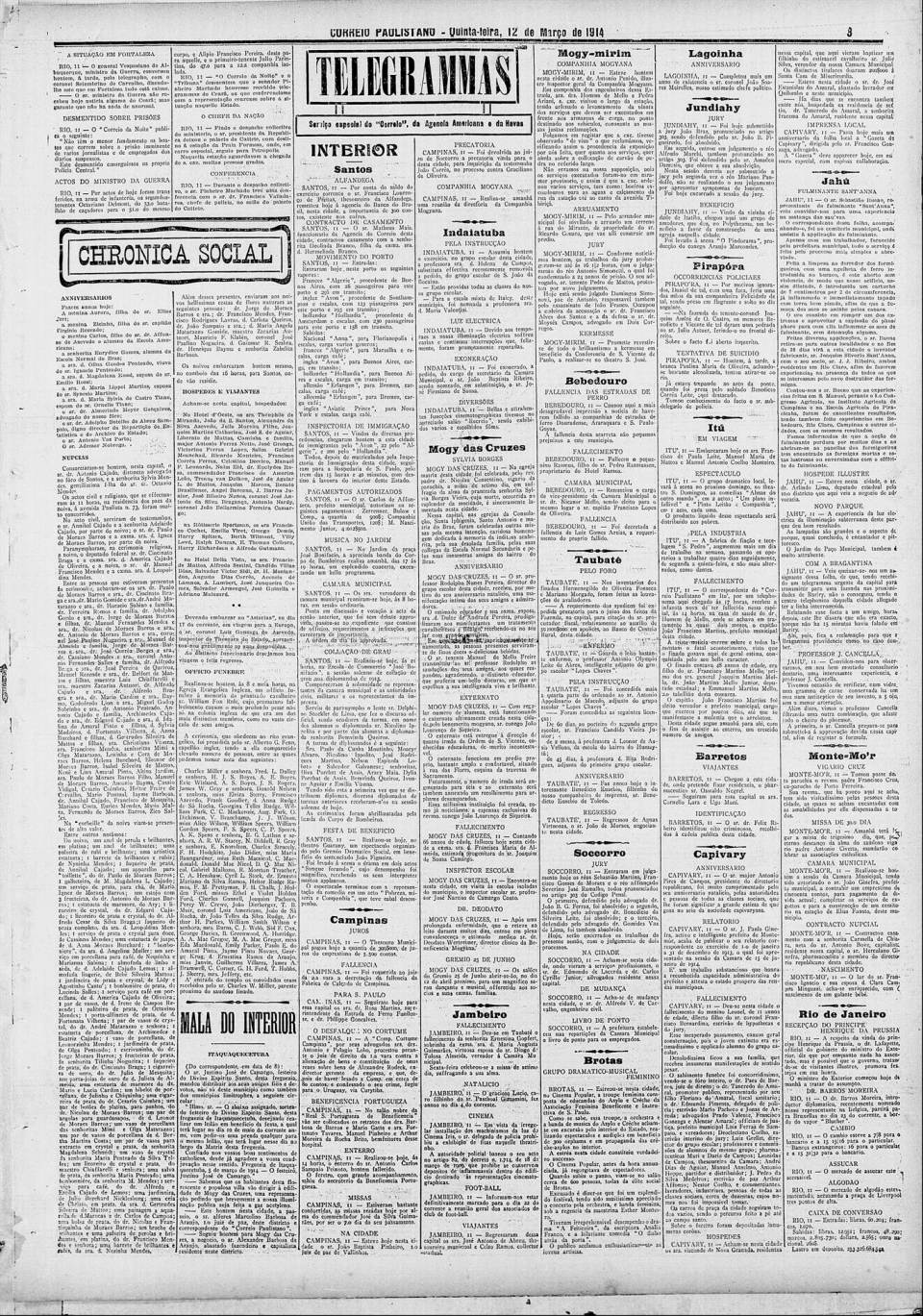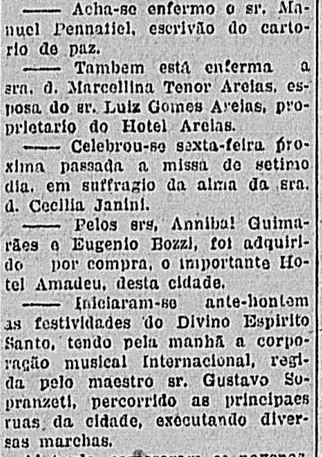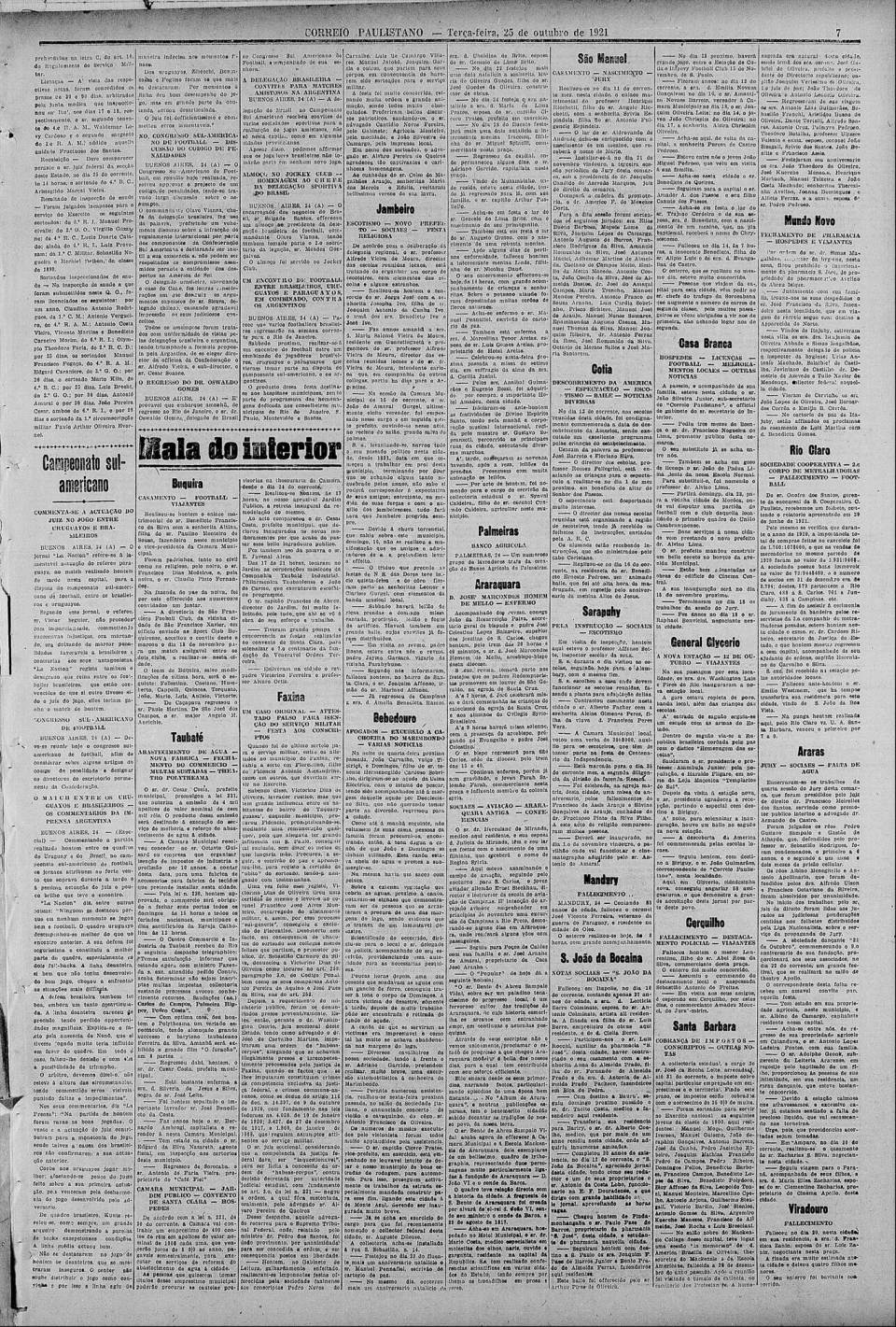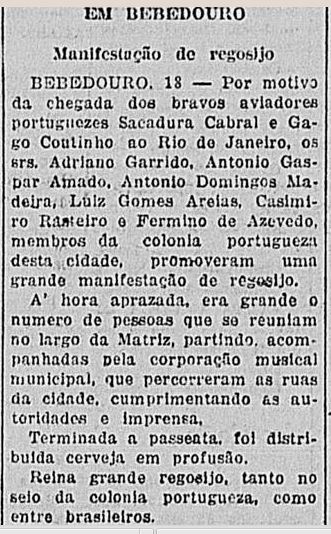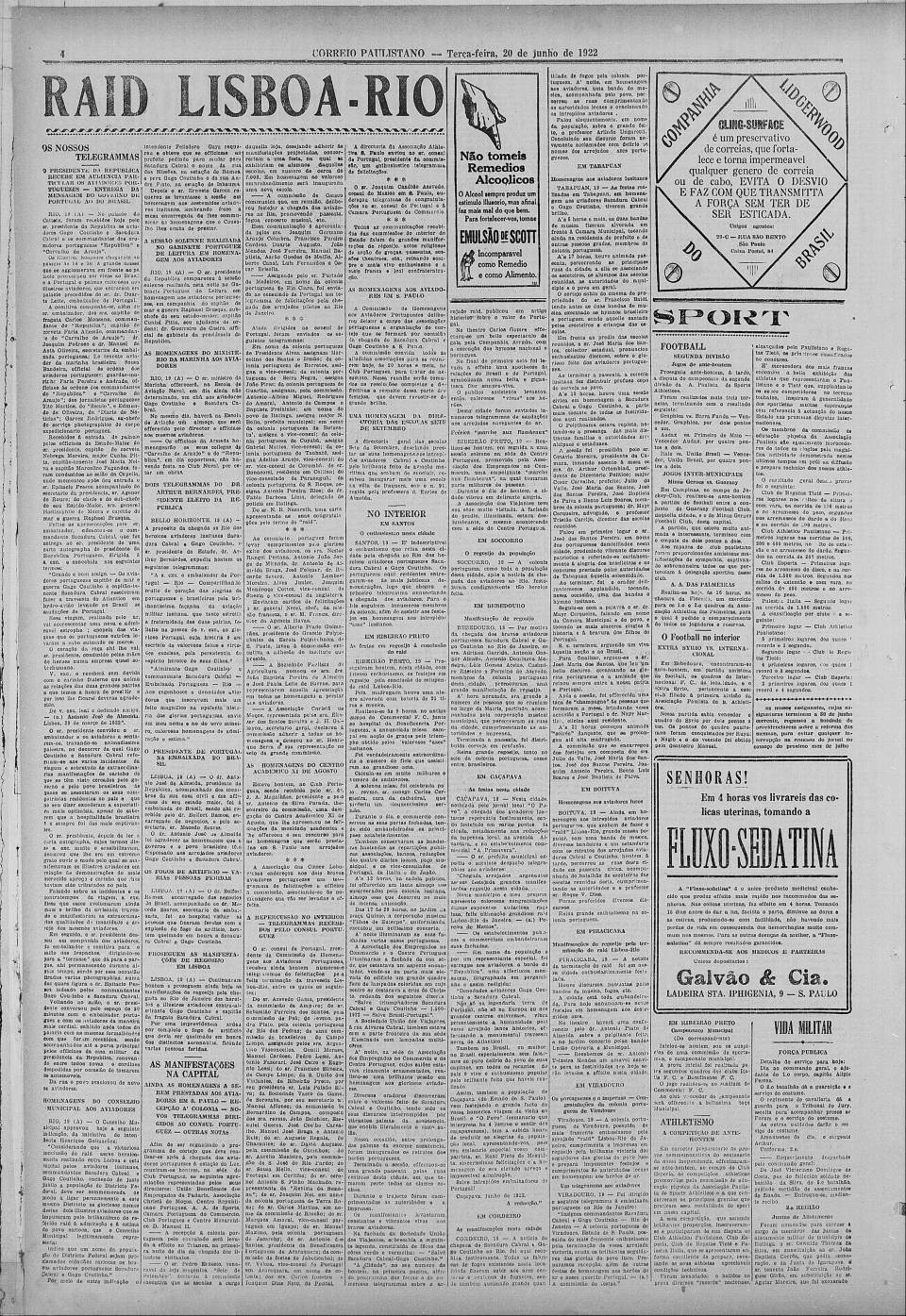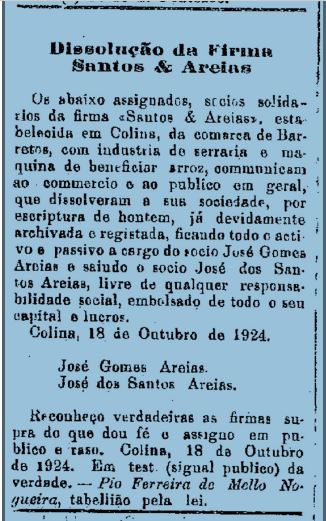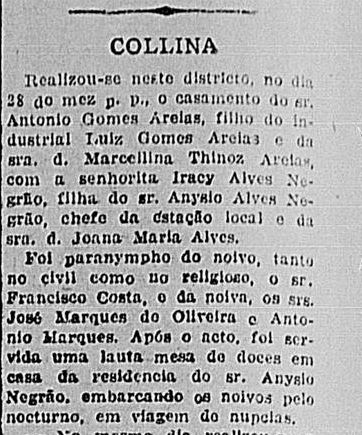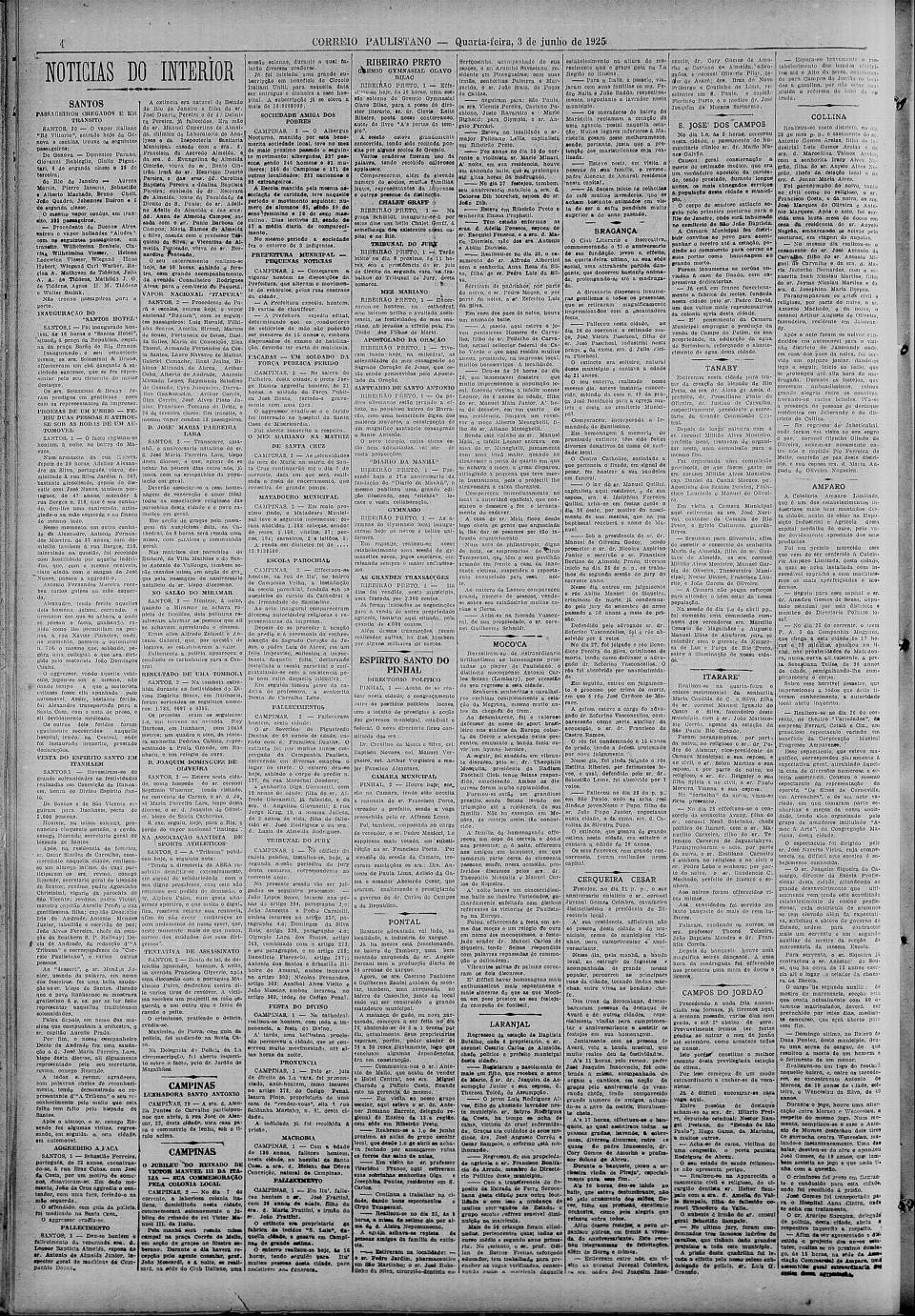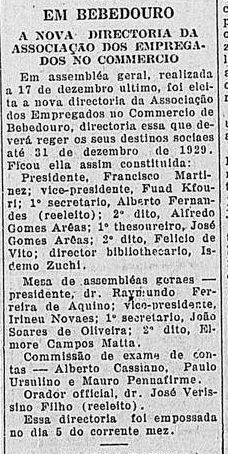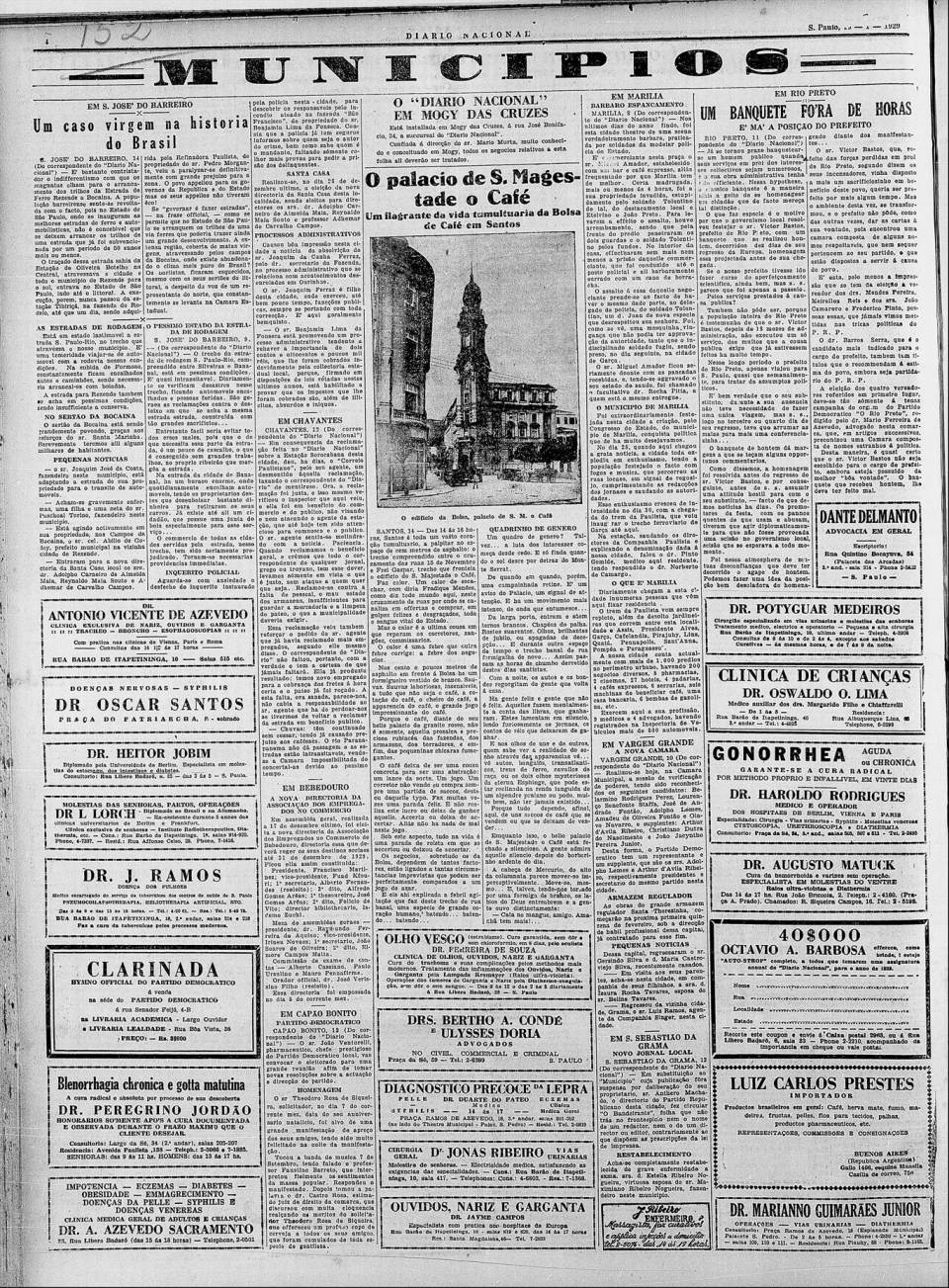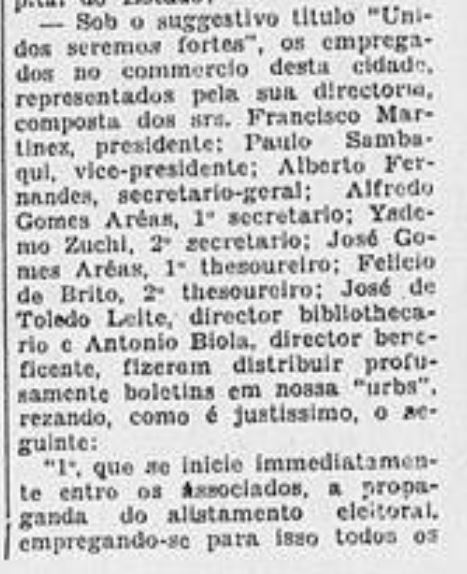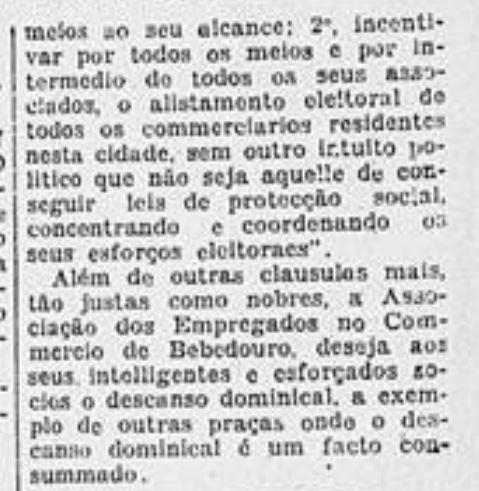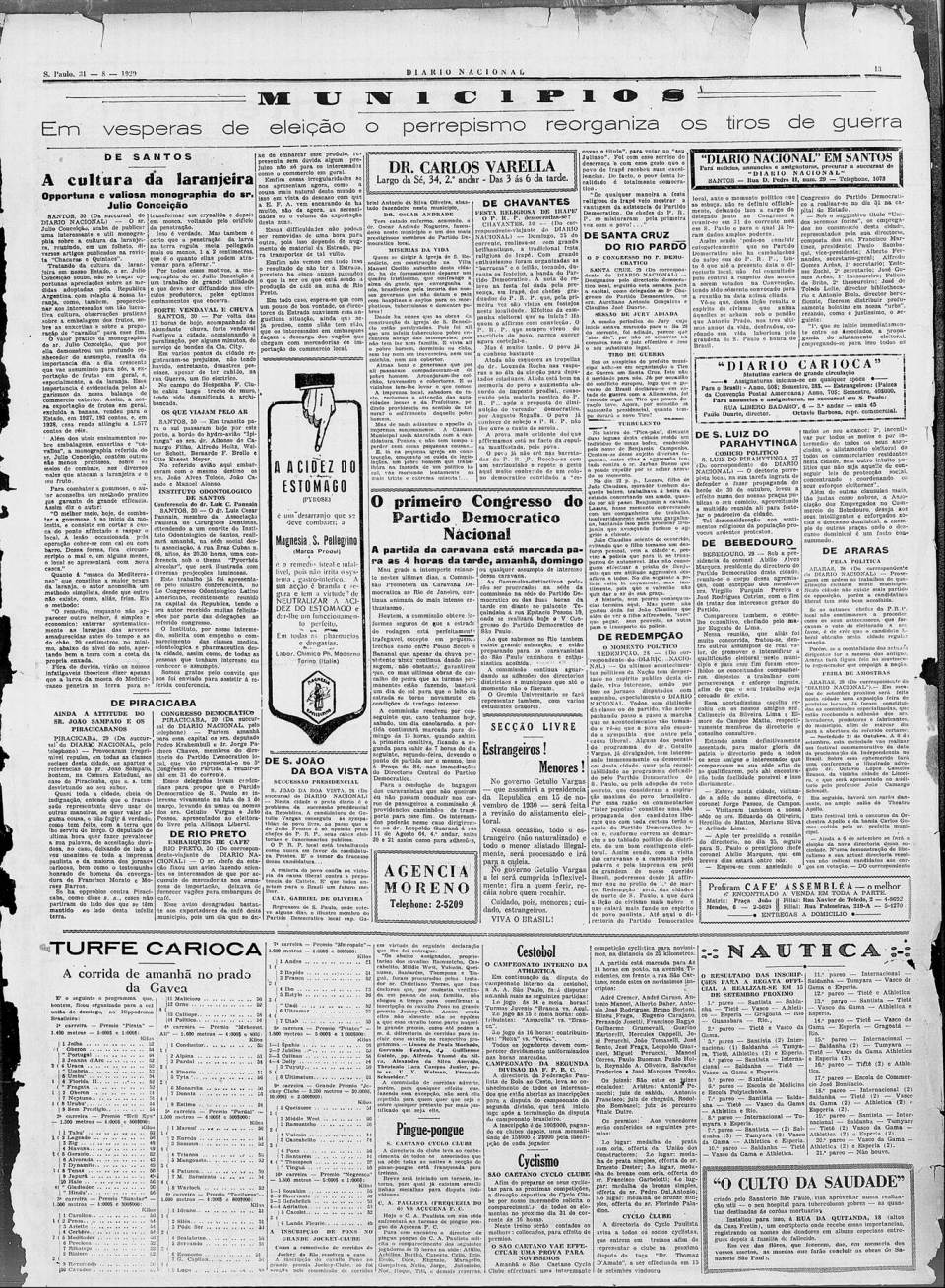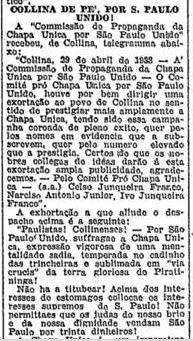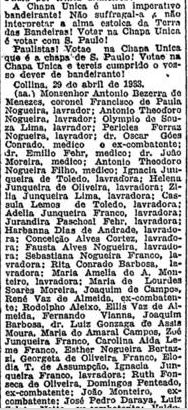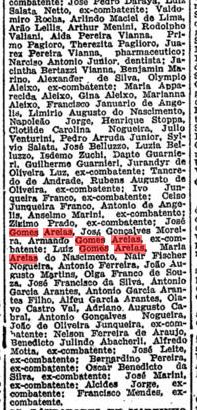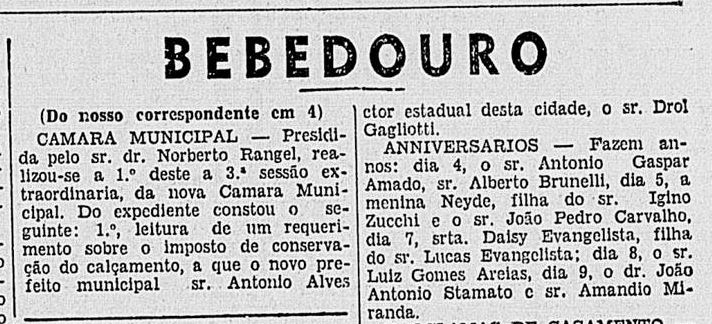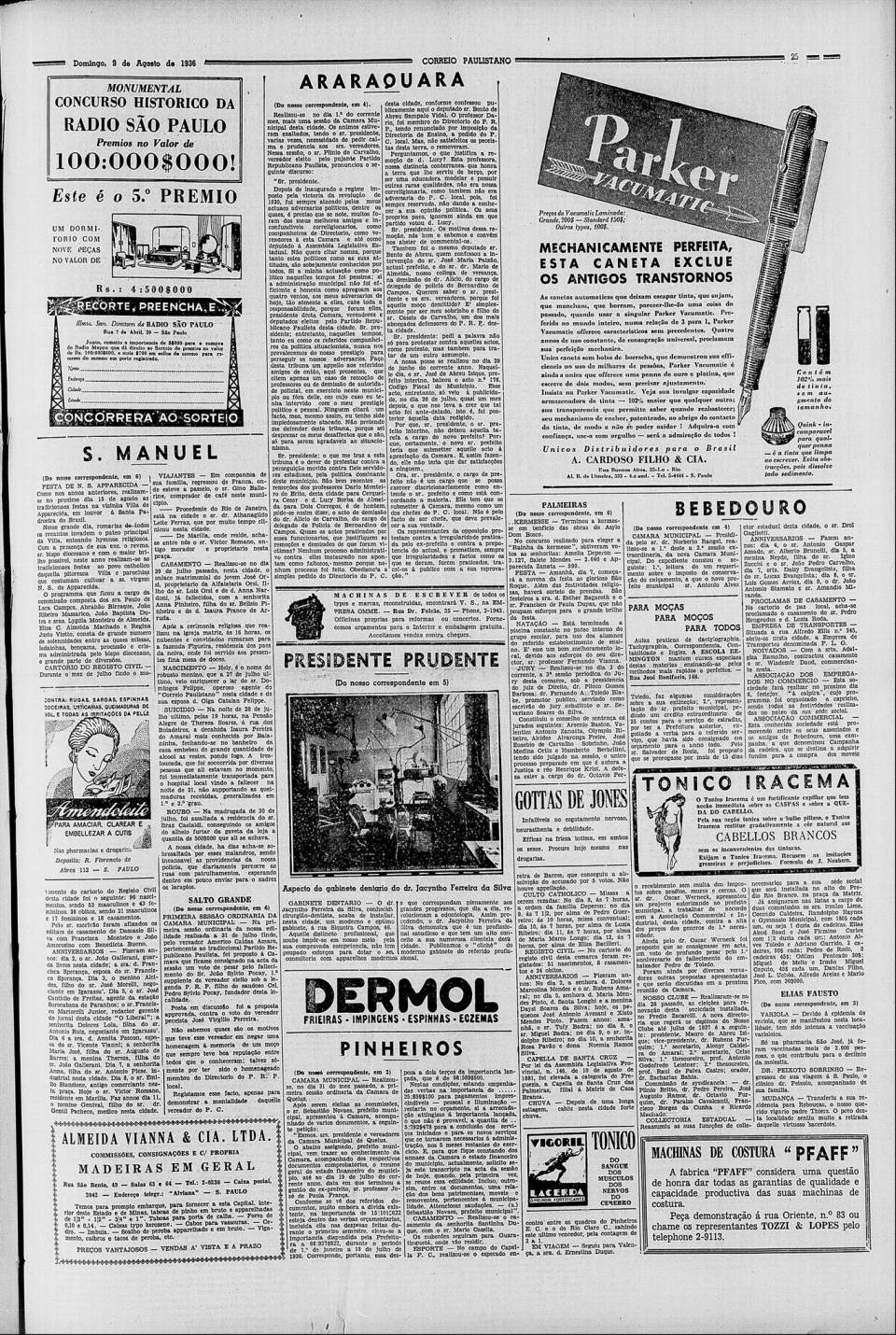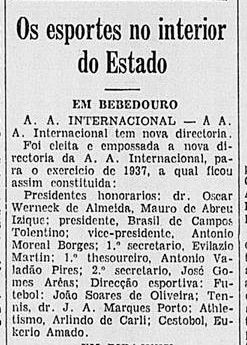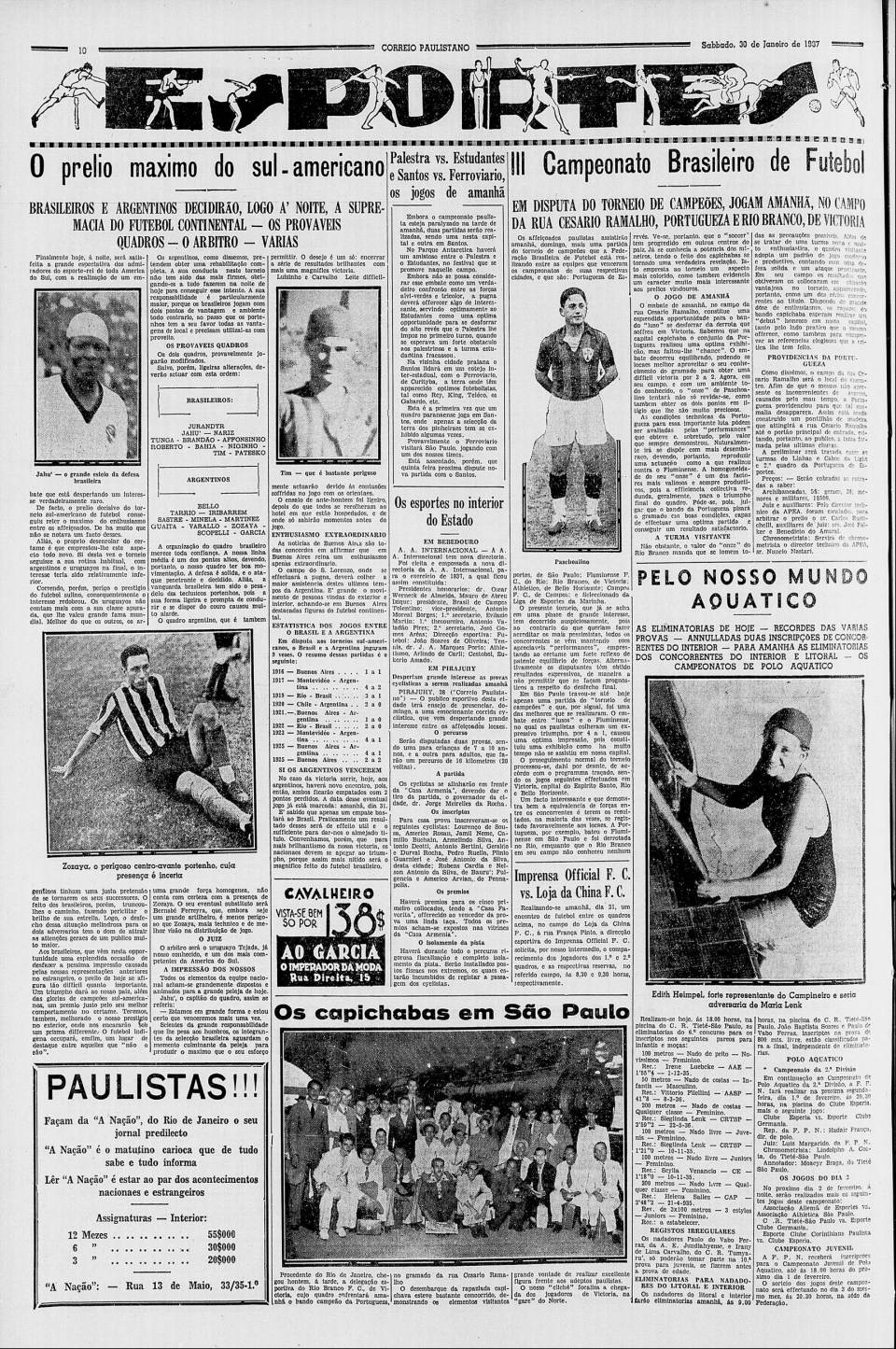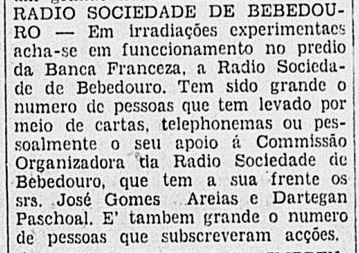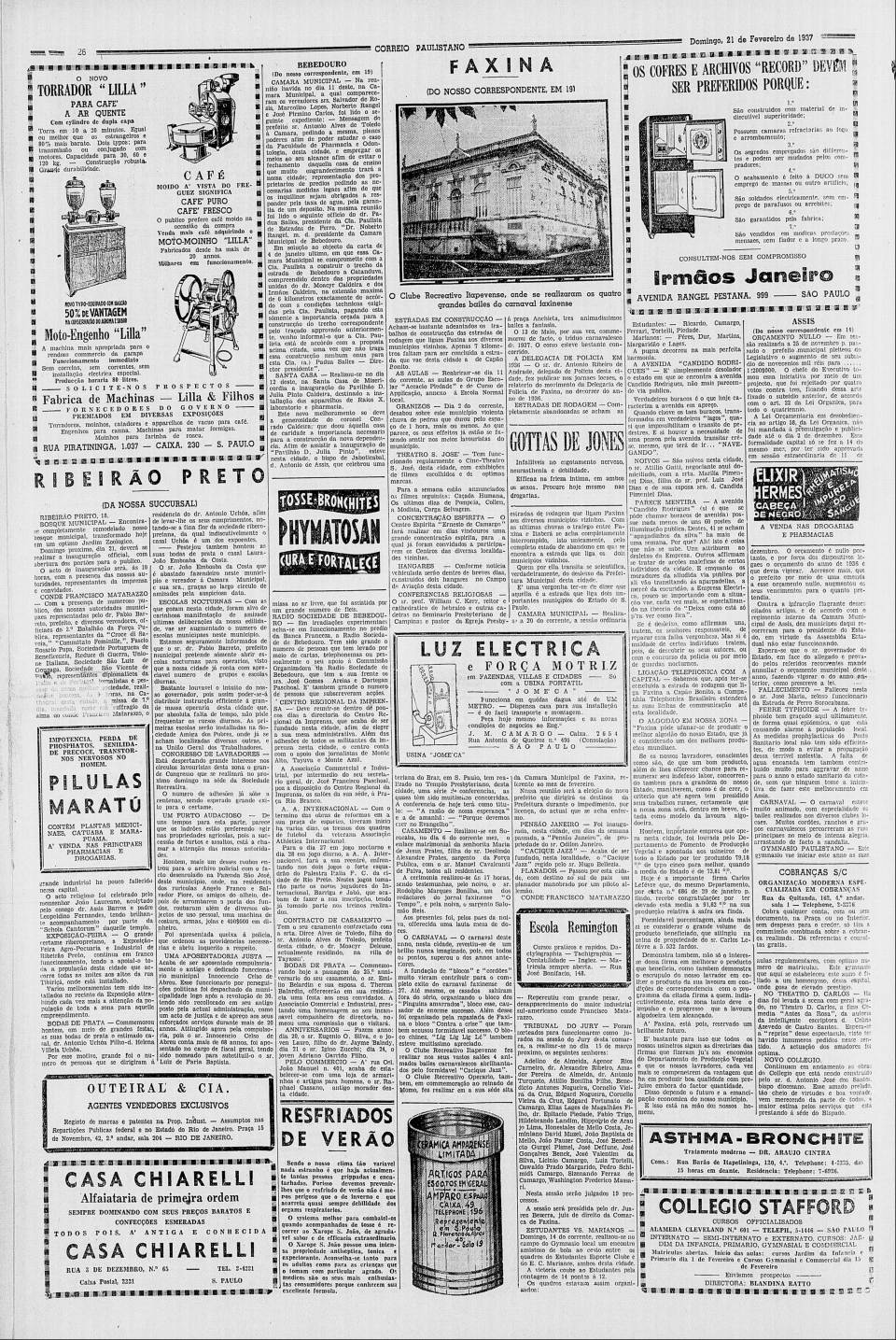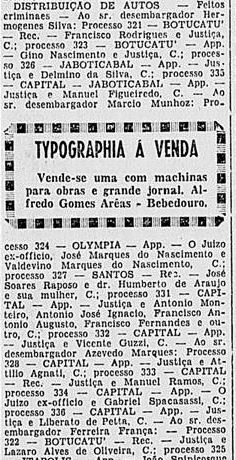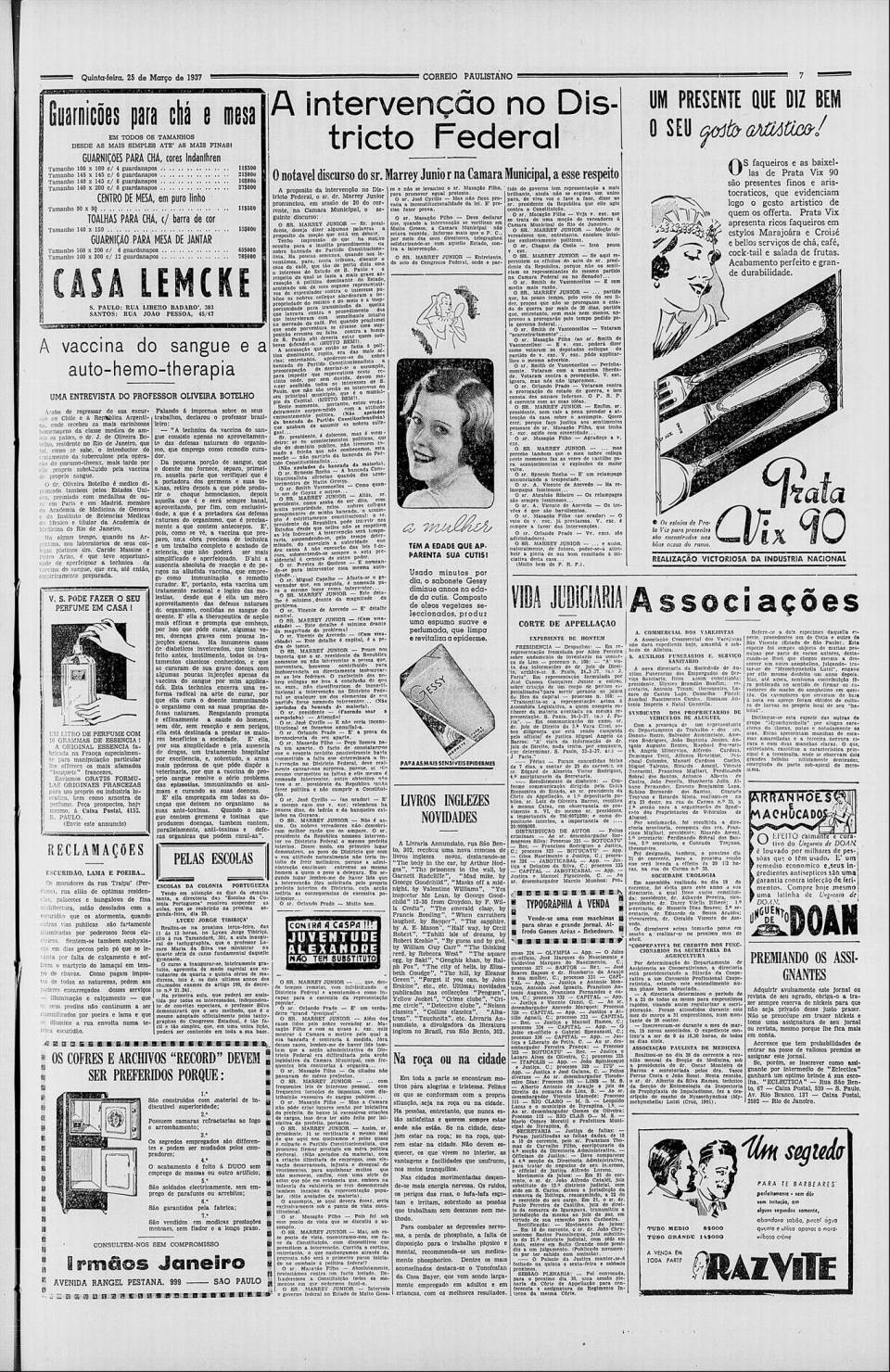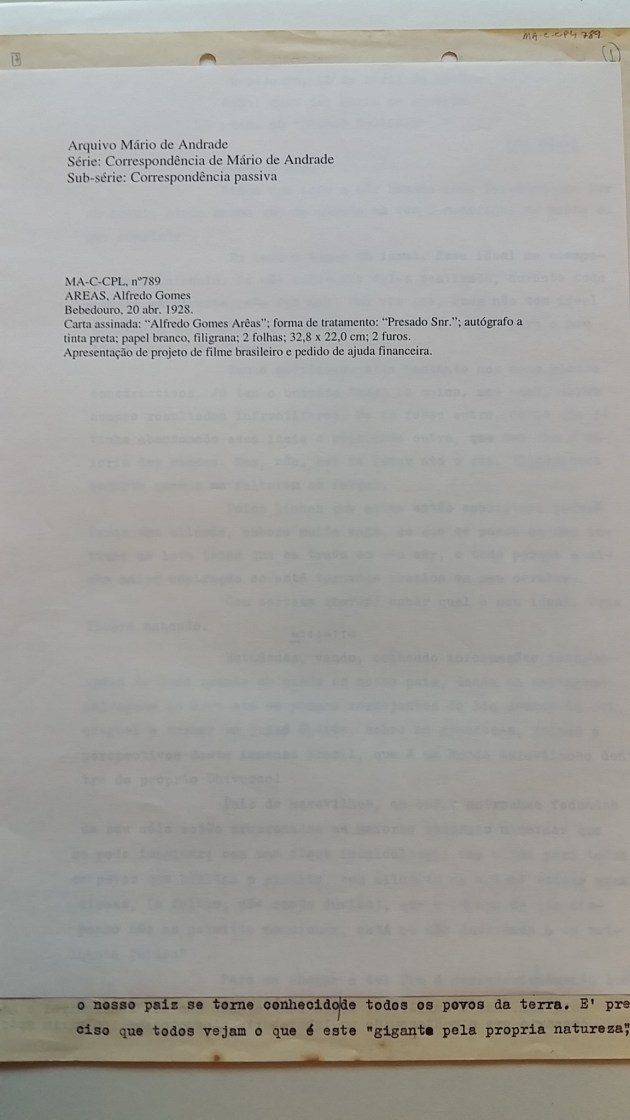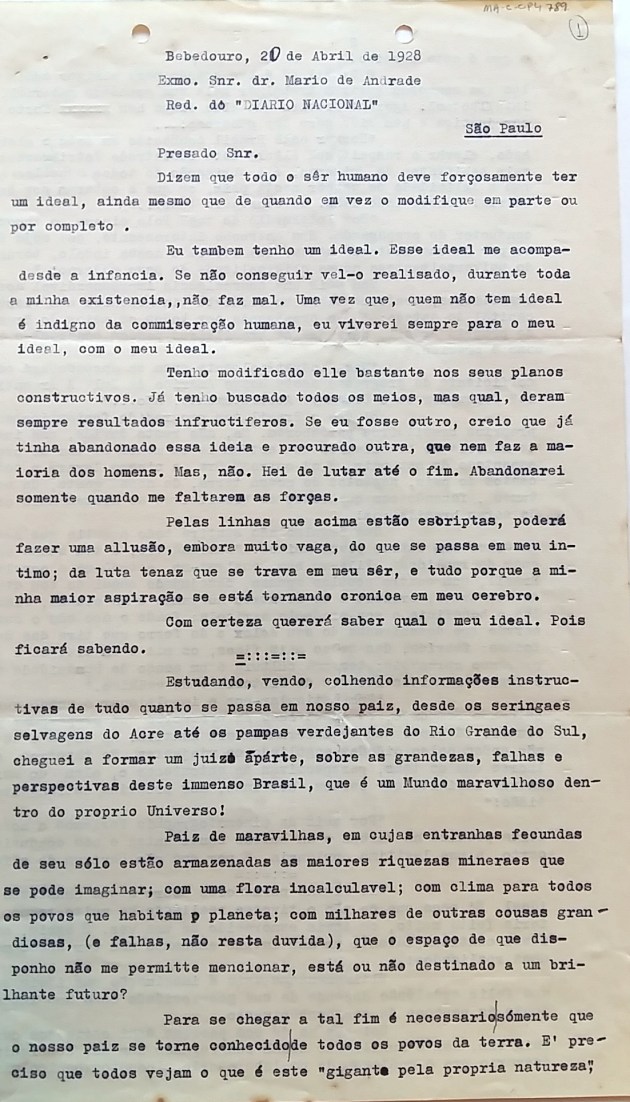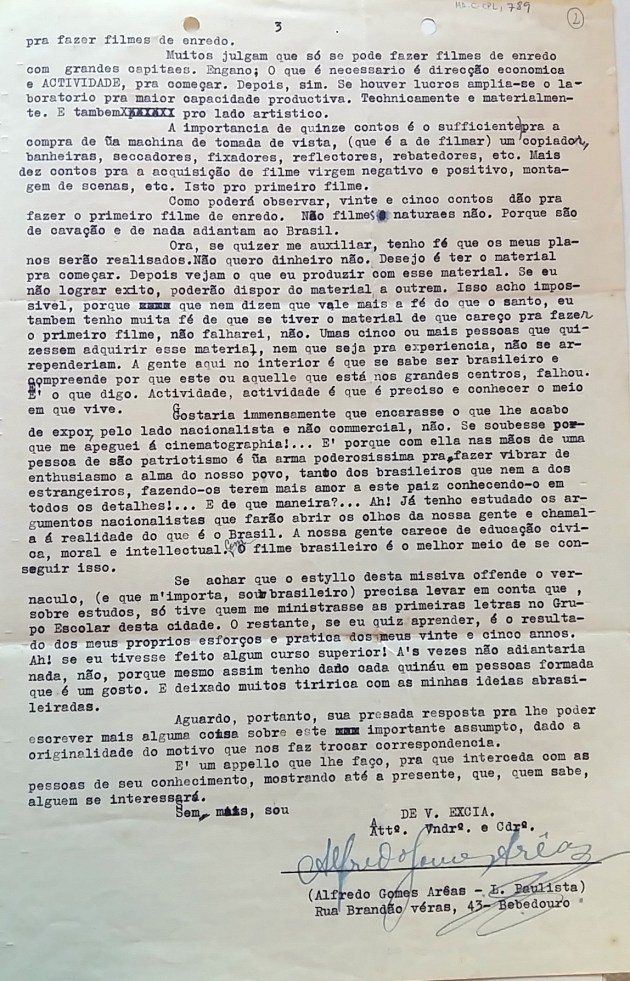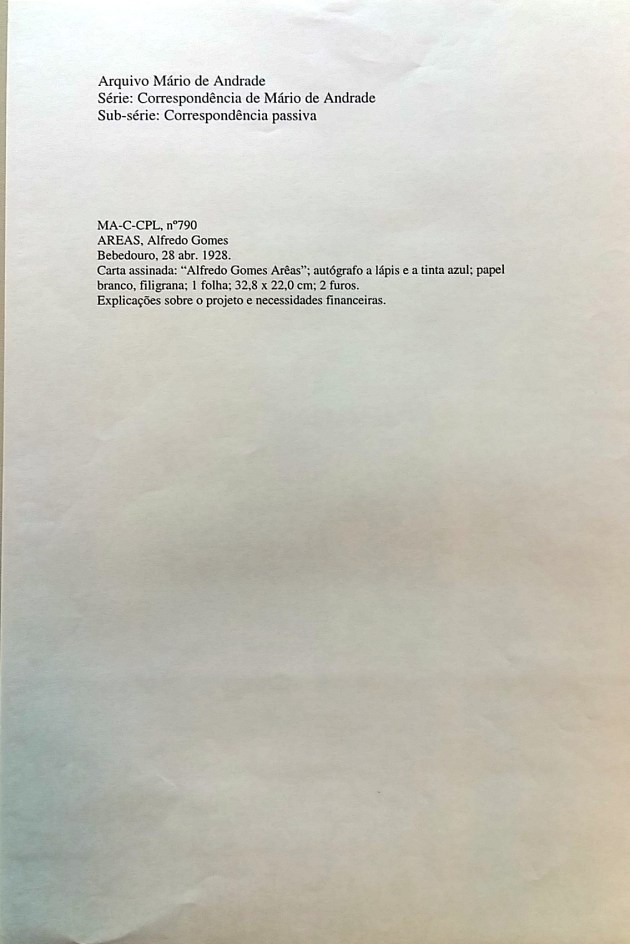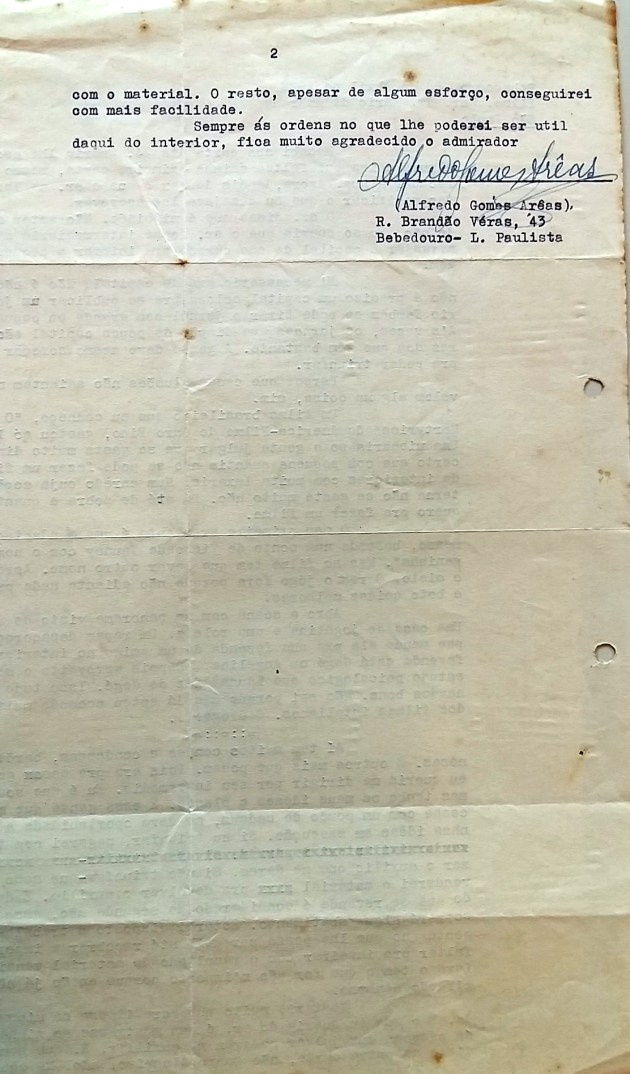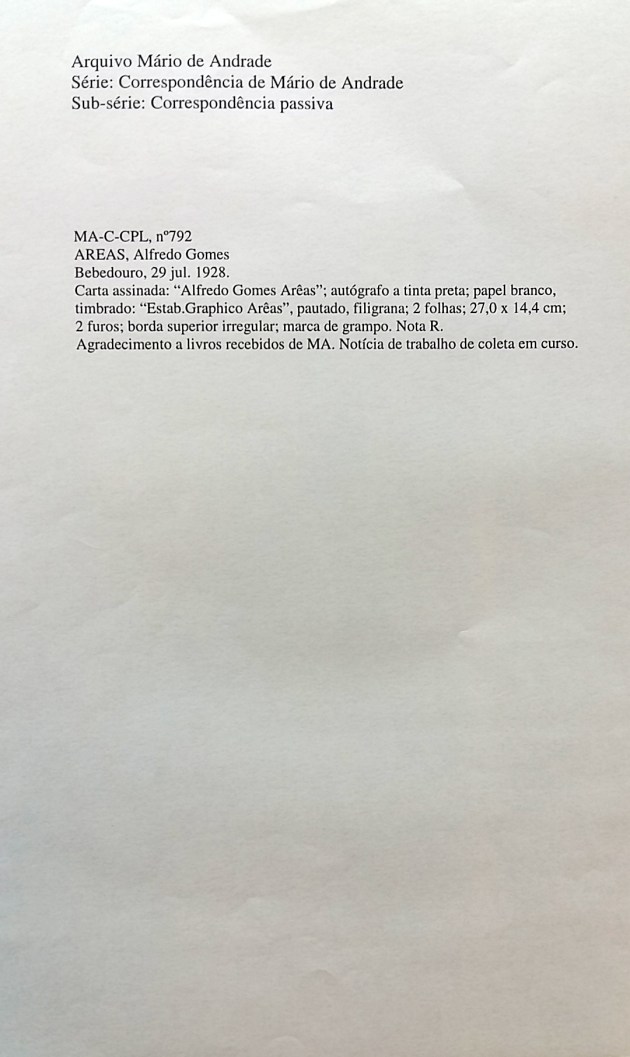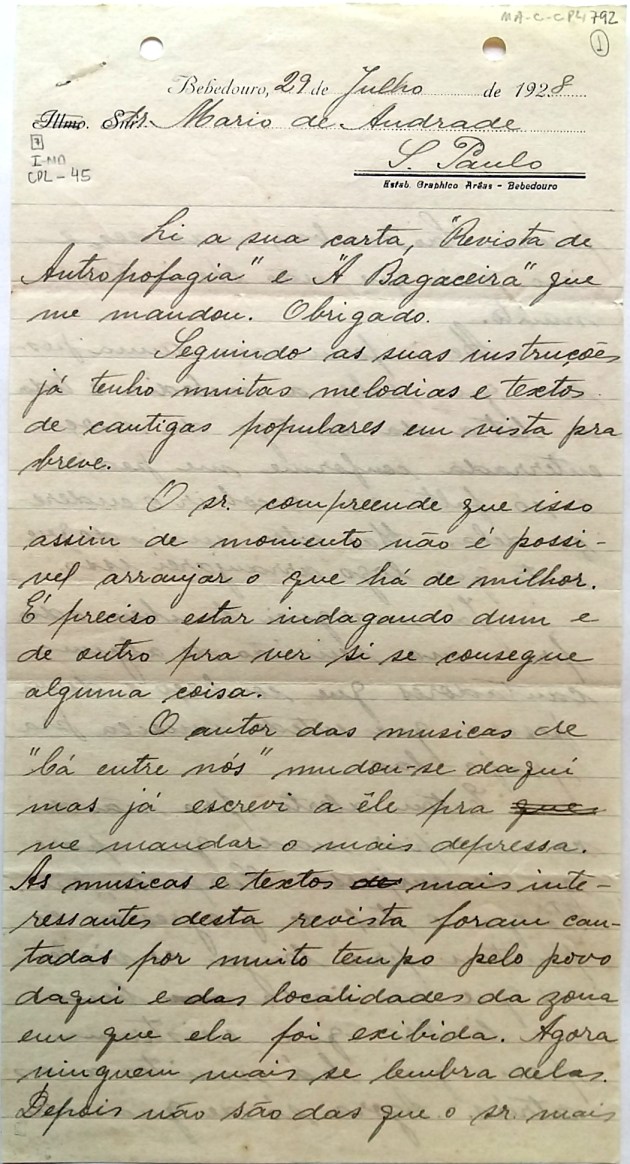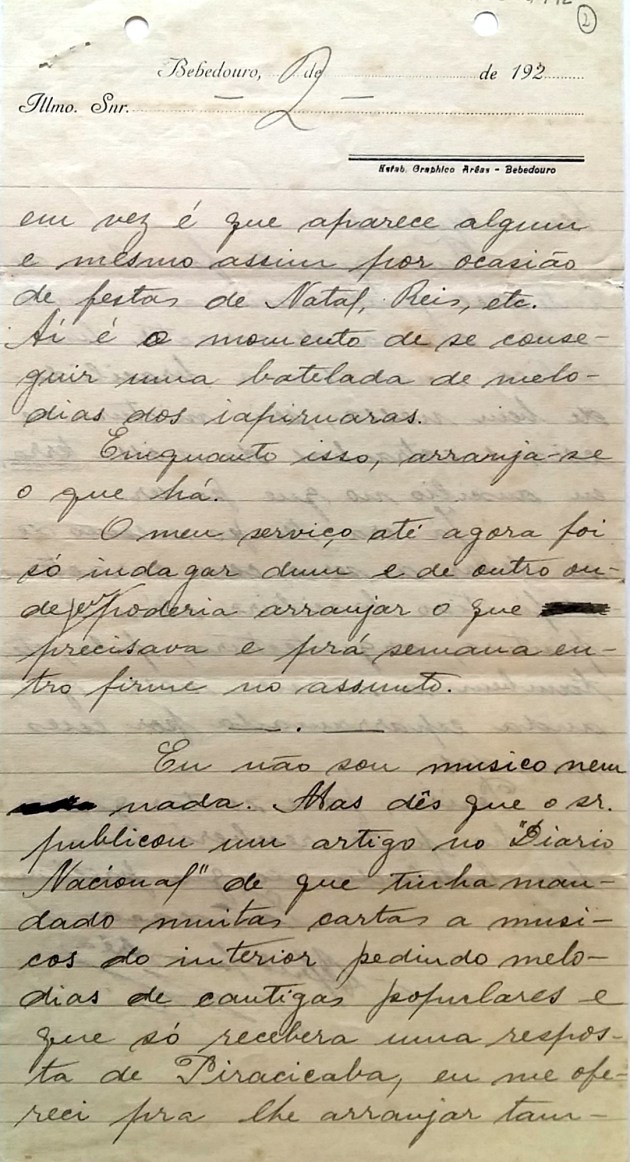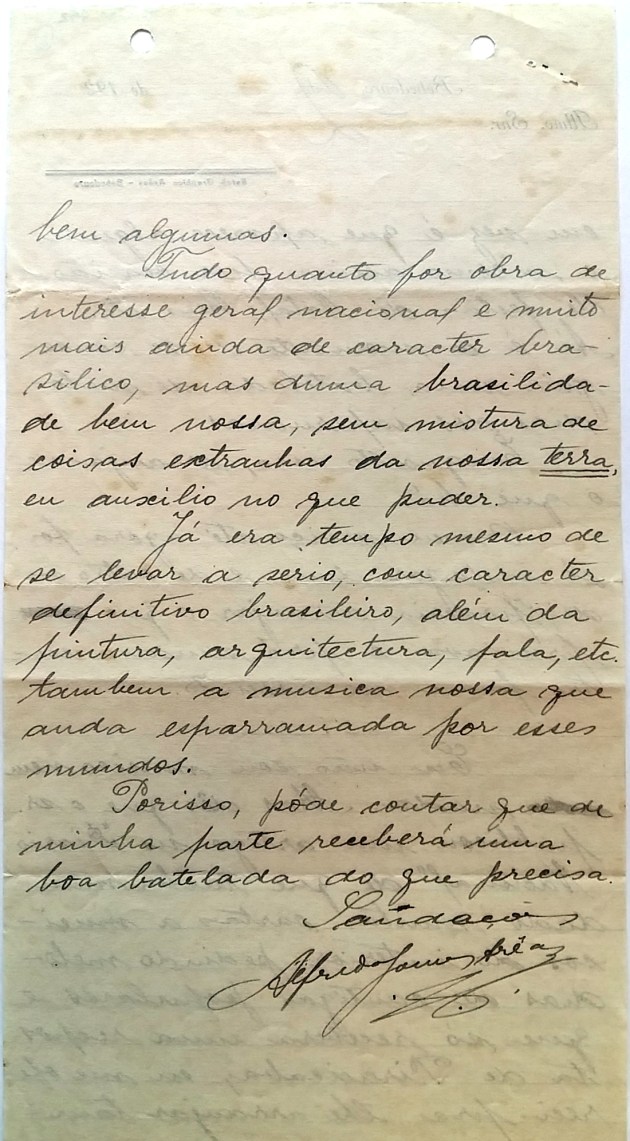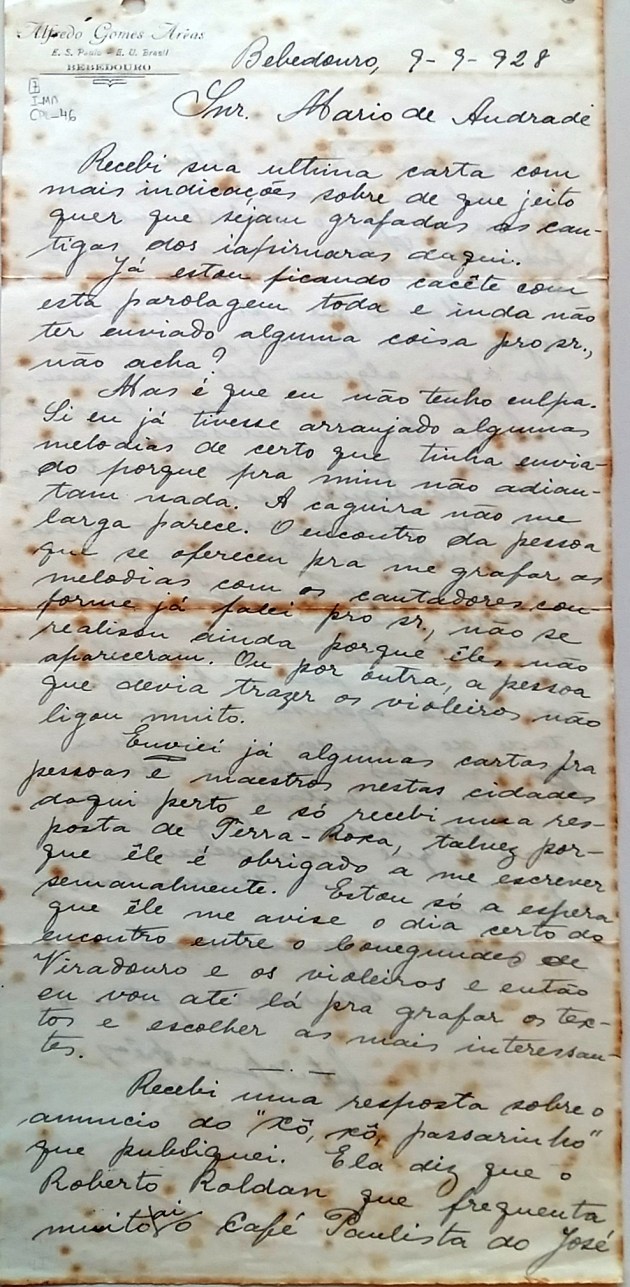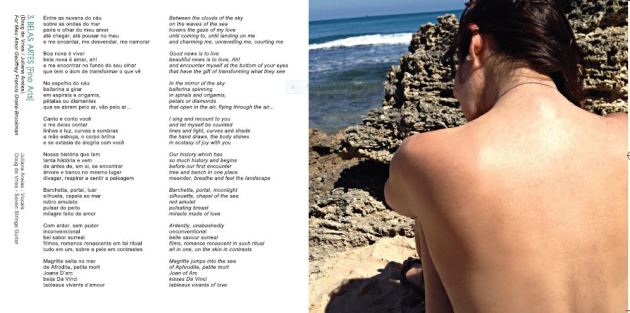SPECIFIC NEWPAPER ARTICLES ABOUT TINOS FAMILY DESCENDANTS
ARTIGOS DE JORNAL ESPECÍFICOS SOBRE DESCENDENTES DA FAMÍLIA TINOS
– Correio Paulistano 28/4/1885 – São Paulo, Brasil.
Antonio Tinos is among the immigrants who made a formal complaint inside the Immigrant Hostel at Bom Retiro – São Paulo.
Antonio Tinos está entre os imigrantes que fizeram uma reclamação formal dentro da Hospedaria dos Imigrantes do Bom Retiro em São Paulo.
Transcription / Transcrição (Correio Paulistano 28/4/1885 – São Paulo, Brasil)
Officio do mesmo, remettendo por cópia, o que dirigiu a s. exc. o sr. presidente da provincia, a respeito de máu agasalho que a grande quantidade de immigrantes chegados ultimamente a Santos alli recebeu. O presedente da associação, disse que absteve-se de fazer qualquer reclamação ao governo provincial por que sabia que este havia tomado as providencias que lhe eram possiveis no caso actual.
Leu-se uma reclamação assignada a 22 do corrente (mês) pelos chefes de familia de immigrantes tyrolezes, actualmente na hospedaria do Bom-Retiro – Piaza Domenico, Vicintini Giacomo, Giacomo Tomancini, Bernardino Antonio, Ollian Giusepe, Valentino Ballaminut, Tinos Antonio (Antonio Tinos), Contim Domenico, Basul Pietro, Mian Luigi, Domenico Diust, Igabin G. Batta, Graton Francesco, Pontin Ivani. Reclamaram elles:
1o Que é illegal que se pague a qualquer outra pessoa e não a elles a gratificação que a provincia concede aos immigrantes, e que tendo elles contratado para virem trabalhar na provincia, não desejam retirar-se dáqui sem que lhes diga quanto é que estão devendo até o presente. O sr. presidente pôz a votos a seguinte questão -póde em face da lei pagar-se a qualquer outra pessoa que não seja o imigrante ou seu legitimo procurador? Os inconvenientes resultantes se se pagar a outrem não serão muito maiores por facilitarem abusos de natureza grave, do que os que resultam de pagar-se ao proprio immigrante?
O sr dr Martinho Prado disse que tendo sido um dos autores da nova lei podia informar o seguinte:
Só duas classes de pessoas podiam receber o auxilio, a saber:
1o O immigrante quande elle viesse sem ser por intermedio de pessoa que houvesse contractado a introdução dellles.
2o O contractador.
Portanto, o pagamento a qualquer outro era illegal.
Discutiram a materia os srs. drs. Vieira de Carvalho, Nicoláu de Queiroz, Elias Chaves, Elenterio Prado, Raphael Paes de Barros, e o sr. J.A. Schriczmeyer.
A conclusão foi que o acto da presidencia, não podia deixar de ser como foi por que encommendados os colonos no regimen da lei antiga, e não tendo a nova lei descrimidado caso algum identico ao que ocorria, o expediente, melhor era mandar pagar aos que haviam adiantado as passagens, que foi o que fez o governo, subjeitando-os a restituir ao thesouro as quantias relativas a immigrantes, que não permanecessem na lavoura o tempo exigido pela lei antiga.
Translation – (Correio Paulistano 28/4/1885 – São Paulo, Brasil).… Office of the same, sent a copy, which was directed to s. Exc. Mr. President of the province, referring to the bad reception given to large number of immigrants arrived to Santos lately. The president of the association said that he refrained from making any complaint to the provincial government because he knew that the latter had taken all possible providence in the present case.
A complaint was lodged on the 22nd of this (month) by the Tyrolean immigrant family heads, currently in the Bom Retiro Hostelry – Piaza Domenico, Vicintini Giacomo, Giacomo Tomancini, Bernardino Antonio, Ollian Giusepe, Valentino Ballaminut, Tinos Antonio (Antonio Tinos), Contim Domenico, Basul Pietro, Mian Luigi, Domenico Diust, Igabin G. Batta, Graton Francesco, Pontin Ivani. They complained:
That it is illegal to pay any other person but them the gratification which the province grants to the immigrants, and that since they have been hired to come and work in the province, they do not wish to leave here without being informed about how much they owe until now. Mr. Presided put a vote the following question: – Could the Province Grant be paid by law to anyone other than the immigrant or his legitimate attorney? Will not the inconveniences resulting from paying others be much greater because they facilitate abuses of a serious nature than those resulting from paying the immigrant himself?
Mr. Martinho Prado said as one of the authors of the new law, he could inform the following:
Only two classes of people could receive the province grant, namely:
1o The immigrant who come without being through a person who had contracted the introduction of them.
2nd The contractor.
Therefore, payment to anyone else was illegal.
The matter was discussed by Mrs. Drs. Vieira de Carvalho, Nicolau de Queiroz, Elias Chaves, Elenterio Prado, Raphael Paes de Barros, and mr. J.A. Schriczmeyer.
The conclusion was that the act of the presidency could not be other because the immigrants were hired under the old law regime, and the new law did not predicted any identical case to what happened. Therefore the better decision was to pay the grant tp those who had advanced the passage custs, which was what the government did, subjecting them to refund to the treasury the amounts relative to immigrants, which did not remain in the field the time required by the old law.
– Correio Paulistano – 16/3/1906, São Paulo, Brasil.
Antonio Tinos’s death notice in São Carlos (5/3/1906 – Mr. Antonio Tinoz)
Nota de falecimento do Antonio Tinos em São Carlos (5/3/1906 – Sr. Antonio Tinoz)
– O Comércio de São Paulo – 16/3/1906, São Paulo, Brasil.
Antonio Tinos’s death notice in São Carlos (5/3/1906 – Mr. Antonio Tinoz)
Nota de falecimento do Antonio Tinos em São Carlos (5/3/1906 – Sr. Antonio Tinoz)
– Journal Officiel de la Republique Française – 3/12/1933). – Bibliothèque Nationale de France, France.
Transcription / Transcrição
“TINOS (Joseph-Louis), maçon, né le 19 août 1885 à Cervignano-del-Friuli (Italie), demoéurant à Saint-Geniez-d’Olt (Aveyreu).”
Translation – TINOS Giuseppe Luigi, builder, born on August 19th 1885 in Cervignano del Friuli, Italy. Resident at Saint-Geniez-d’Olt (Aveyreu).
Tradução – TINOS Giuseppe Luigi, pedreiro, nascido em 19 de agosto de 1885 em Cervignano del Friuli, Italia. Residente em Saint-Geniez-d’Olt (Aveyreu).
Giuseppe Luigi Tinos (Bebo) (VI) *19/8/1885, son of Giovanni Tinos & Eugilda Blandida de Checco; married Maria Gregoratti in Visco -1/3/1924.
He emigrate to France. He appears alone and without descendants as a new French citizen at the French Republic Official Newspaper on 3/12/1933: In the emails below (2016), a prosecutor searches for his descendants. Marine Judge Luciano Giacomi, son of Valeria Fereguin and grandson of Ernesta Catarina Tinos (sister of Giuseppe Luigi Tinos) died without leaving heirs. His Valeria Fereghin died with 101 year old, just a year before her son Luciano Giacomi. Giorgio Tinos (son of Pia Tinos and grandson of Attilio Tinos also brother of Giuseppe Luigi and Ernesta Catarina) in 2016 tells that he used to go on holidays from the orphanage to the Fereghin’s house, which he remembers with kindness always. Giorgio became his mother’s orphan very early and never knew his father. Giorgio lives in Queensland, Australia, with his Australian wife Louise Child and their two daughter Gisela Tinos and Jana Tinos.
Giuseppe Luigi Tinos (Bebo) (VI) *19/8/1885, filho de Giovanni Tinos & Eugilda Blandida de Checco; casou-se com Maria Gregoratti in Visco -1/3/1924.
Ele emigrou para a França, one aparece sozinho e sem descendentes como um novo cidadão francês no Jornal Oficial da República Francesa em 3/12/1933: Nos emails abaixo de 2016, uma procuradora busca por descendentes seus. O Juiz da Marinha Luciano Giacomi, filho de Valeria Fereguin e neto de Ernesta Catarina Tinos (irmã de Giuseppe Luigi Tinos) morreu sem deixar herdeiros. A mãe Valeria Fereguin morreu com 101 anos, apenas um ano antes do seu filho Luciano Giacomi. Giorgio Tinos (filho de Pia Tinos e neto de Attilio Tinos também irmão de Giuseppe Luigi e Ernesta Catarina) em 2016 conta que costumava ir nas férias do orfanato para a casa dos Fereghin, dos quais se lembra com carinho sempre. Giorgio ficou órfão da mãe muito cedo e nunca conheceu o pai. Giorgio mora em Quensland, na Austrália com sua esposa australiana Louise Child e suas duas filhas Gisela Tinos e Jana Tinos.
– Jornal Tribuna de São Carlos – Pró Memória – Pesquisadora encontra informações sobre as origens de sua família – 7/10/2007, Brasil.
Article featuring Juliana Areias about Tinos Family research and the first Tinos Family reunion in Brazil, in 2007.
Artigo com Juliana Areias sobre a pesquisa e primeiro encontro da Família Tinos no Brasil, em 2007.
Transcription / Transcrição (Jornal Tribuna de São Carlos – 7/10/2007, Brasil)
Pró Memória – Pesquisadora encontra informações sobre as origens de sua família
Ancestrais chegaram a São Carlos em 1885 – um encontro de parentes será realizado neste domingo em restaurante do distrito de Santa Eudóxia
Juliana Areias encontrou dados sobre o casamento de seis dos filhos de Antônio e Elisabetta.
Juliana Areias, paulistana de 32 anos, ouvia desde criança as recordações de seus avós lembrando histórias a respeito dos pais deles, contando que eram austríacos de Viena.
Juliana questionava os avós: então por que não falam alemão? E os avós respondiam que a família falava “furlan”. Isso deixava Juliana muito curiosa.
Essa curiosidade ficou latente a maior parte de sua vida. Aos 18 anos foi morar na Bahia, graduou-se em Belas Artes pela Universidade Federal e dedicou-se à música, iniciando uma carreira de cantora. Aos 21 anos foi para a Suíça, onde conheceu Rogério Teixeira da Mata, metalúrgico de São Bernardo do Campo que estava trabalhando lá. Casaram e vieram ao Brasil em 2000, quando ficaram sete meses viajando pelo país visitando os parentes das duas famílias. Foi nessa ocasião que aguçou sua curiosidade sobre as origens da sua família. Ela voltou a questionar a tia e a avó e soube que os ancestrais tinham vivido em São Carlos.
Nova Zelândia – Ainda em 2000, o casal seguiu para a Nova Zelândia, onde ela teve a sorte de engajar-se num projeto acadêmico, sobre samba, na escola de música da Universidade de Auckland. Trabalhou na instituição dois anos e continuou fazendo apresentações em bares, restaurantes, animando festas e casamentos e participando de alguns festivais de música. Mesmo tão longe do Brasil, a curiosidade continuava acesa e nas horas vagas buscava as respostas sobre as origens da família, pesquisando na internet e ingressando em grupos de discussão de genealogia.
O marido, depois de algum tempo como chefe de cozinha de um restaurante, obteve trabalho na sua profissão, ingressando numa empresa como torneiro mecânico. Em 2002 nasceu Jobim, o primeiro filho do casal. Para Juliana foi um “sinal” de que eles deveriam continuar morando por lá. Em 2005 nasceu Lilás. Os filhos representaram novo estímulo para buscar as origens. Ela conta que sentiu que, mais do que nunca, precisava conhecer a história dos ancestrais, “para deixar a meus filhos essa herança, a memória da família”.
Desenrolando o novelo –Não foi fácil desenrolar o fio do novelo com as pistas das origens da família, para achar as respostas que procurava. Escreveu muitas cartas para a Áustria, mas nunca recebeu uma resposta.
Ficou entusiasmada quando um primo, Felício Cabral Mendes, conseguiu localizar a chegada a Santos dos ancestrais no vapor “Maria”, em 16 de abril de 1885.
Depois, pela internet, num grupo e discussão sobre genealogia, contatou o historiador italiano Ugo Perissinotto, que ajudou bastante a desvendar as origens da família.
Foi localizando parentes e criou e mantém na internet um grupo que pode ser acessado no endereço https://br.groups.yahoo.com/groups/familiatinos/.
Antônio e Elizabetta – Juliana Areias afirma que, “ao que tudo indica, no Brasil, todos os ramos são descendentes de um mesmo tronco familiar:o casal Antônio Tinos e Elisabetta Grassetti Tinos (Isabel) e seus 8 filhos: Celestina, Luigi (Luiz), Maria (Anna Maria), Giuseppe (José), Caterina, Antônio, Marcelina (minha bisavó) e Eugênia”.
Ela acrescenta que “do Porto de Santos a família seguiu para São Carlos, onde eles trabalharam ao menos em duas fazendas, Boa Esperança e Santa Eudóxia. Descobri também que eles falavam realmente o edioma “furlan” e eram originários de Strassoldo, que na época pertencia à Província de Gorizia (Gorz) como território do Império Austro-Húngaro e hoje é parte da Itália, pertencendo à Comune Cervignano del Friuli, Província de Udine, Região Friuli Venezia Giulia.”
Na Pró-Memória – Agora de volta ao Brasil para uma temporada de quatro meses, Juliana e Rogério, trazendo Jobim e Lilás, vieram desta vez para apresentar as crianças aos familiares.
Na semana passada, de passagem por São Carlos, Juliana aproveitou para pesquisar no banco de dados de habilitações de casamento do Arquivo Público e Histórico da Cidade, da Fundação Pró-Memória, entidade vinculada à Prefeitura Municipal, no qual encontrou dados sobre o casamento de seis dos oito filhos de Antônio e Elisabetta Tinos. Ela comenta que, nos últimos anos, em contato com outros pesquisadores, especialmente graças a Sônia Trombelli, tem ouvido falar bem da instituição são-carlense, na qual diz ter sido muito bem atendida.
Ela conta ainda que, ao longo de sua pesquisa, achou parentes em vários estados brasileiros e também nos EUA. E revela que espera reunir cerca de setenta membros da parentela neste domingo (7), no Restaurante Dom Mineiro, em Santa Eudóxia, localidade escolhida para o encontro por ter sido um dos primeiros pontos de fixação da família no Brasil.
Translation – (Jornal Tribuna de São Carlos – 7/10/2007, Brasil)
“Pro Memoria” (Pro Memory) – Researcher finds information about the origins of her family
Ancestors arrived in São Carlos in 1885 – a family reunion will be held this Sunday in a restaurant in the district of Santa Eudoxia
Juliana Areias found data on the marriage of six of the children of Antonio and Elisabetta.
Juliana Areias, a 32-year-old from São Paulo, had listened to her grandparents remembering stories about their parents, telling them they were Austrians from Vienna.
Juliana questioned the grandparents: so why don’t they speak German? And the grandparents answered that the family spoke Furlan. That made Juliana very curious.
This curiosity stayed dormant for most of hes life. At the age of 18, she moved to Bahia, graduated in Fine Arts from the Federal University and dedicated herself to music, starting a singing career. At age 21 she went to Switzerland, where she met Rogério Teixeira da Mata, a turner-fitter from São Bernardo do Campo who was working there. They married and came to Brazil in 2000, when they spent seven months traveling around the country visiting relatives of the two families. It was on this occasion that she whetted hes curiosity about the origins of hes family. She again questioned her aunt and grandmother and learned that the ancestors had lived in Sao Carlos.
New Zealand – Also in 2000, the couple moved to New Zealand, where she was fortunate enough to work in an academic project on samba at the University of Auckland’s music school. She worked in the institution for two years and continued to perform as a singer in bars, restaurants, celebrations and weddings and participating in some music festivals. Even so far from Brazil, curiosity ticked on and her free time, she sought answers about the origins of the family, searching the internet and joining genealogy discussion groups.
Her husband, after some time as head chef of a restaurant, got a job in his profession, joining a company as a fitter-turner. In 2002 was born Jobim, the couple’s first child. For Juliana it was a “sign” that they should continue to live there. In 2005 Lilás was born. The children represented a new stimulus to seek her origins. She says she felt that more than ever she needed to know the history of their ancestors, “to give my children this inheritance, the family memory.”
Piecing together the puzzle -It was not easy to unfold the origins of the family and to find new clues and the right answers she wanted. She wrote many letters to Austria but never received an answer.
She felt enthusiartic when a cousin, Felício Cabral Mendes, managed to locate the arrival register of their ancestors in the steamship “Maria”, on April 16th, 1885.
Then, through the internet genealogy forums, she contacted the Italian historian Ugo Perissinotto, who helped a lot to unravel the origins of the family.
She has loccated relatives and created and maintained a group on the internet that can be accessed at https://br.groups.yahoo.com/groups/familiatinos/.
Antônio and Elizabetta – Juliana Areias affirms that, “it seems that in Brazil, all family branches are descended from the same couple Antônio Tinos and Elisabetta Grassetti Tinos (Isabel) and their 8 children: Celestina, Luigi (Luiz), Maria (Anna Maria), Giuseppe (José), Caterina, Antônio, Marcelina (my great-grandmother) and Eugênia.
She added that “from the port of Santos, the family went to São Carlos, where they worked on at least two farms, “Boa Esperança” and “Santa Eudoxia”. I also discovered that they really spoke Furlan, and that they were from Strassoldo, which at the time was part of the Province of Gorizia (Gorz) as a territory of the Austro-Hungarian Empire and today is part of Italy, belonging to the Comune Cervignano del Friuli, Province of Udine, Region Friuli Venezia Giulia.
In Pró-Memória (Pro-Memory) – Now returning to Brazil for a four-month stay, Juliana and Rogério, bringing Jobim and Lilás, came this time to introduce the children to their families.
Last week, when passing through São Carlos, Juliana took the opportunity to search the database of marriage qualifications of the Public and Historic Archive of the City, the Pro-Memory Foundation, which is linked to the City Council, in which she found data on the marriage of six of the eight children of Antonio and Elisabetta Tinos. She comments that in recent years, keeping contact with other researchers, especially thanks to Sonia Trombelli, she has heard a lot about this institution in São Carlos, in which she says she has been very well attended.
She also says that, throughout her research, she found relatives in several Brazilian states and also in the United States. She reveals that she expects to gather about seventy members of hes family this Sunday (7), at the Dom Mineiro Restaurant in Santa Eudoxia, chosen as the location for this family reunion because it was one of the family’s first fixation points in Brazil.
AREIAS FAMILY ARTICLES (DESCENDANTS OF MARCELLINA TINOS)
ARTIGOS DA FAMÍLIA AREIAS (DESCENDENTES DA MARCELLINA TINOS)
– Correio Paulistano 4/2/1914 – (Bebedouro), São Paulo, Brasil.
The Odeon Cinema is bought by Luiz Gomes Areias (Marcellina Tinos’s husband), a business based in Bebedouro City, part of São Paulo State.
O Cinema Odeon é comprado por Luiz Gomes Areias ( Marido da Marcellina Tinos), comerciante domiciliado na cidade de Bebedouro, no interior do Estado de São Paulo.
– Correio Paulistano – 11/3/1914 – (Bebedouro), São Paulo, Brasil.
Luiz Gomes Areias (Marcellina Tinos’s husband) declares his own bankruptcy.
Luiz Gomes Areias (marido da Marcellina Tinos) declara sua própria falência.
– Correio Paulistano, 25/10/1921, (Bebedouro), São Paulo, Brasil.
Nota sobre a doença de Marcellina Tinos Areias), esposa do sr. Luiz Gomes Areias, proprietário do Hotel Areias.
Note about Marcellina Tinos Areias‘s illness, wife of Mr. Luiz Gomes Areias, owner of Areias Hotel.
Transcription / Transcrição (Correio Paulistano, 25/10/1921, Bebedouro)
… Está enferma a sra. Marcellina Tenor Areias (Marcellina Tinos Areias), esposa do sr. Luiz Gomes Areias, proprietário do Hotel Areias.
Translation – Ms. Marcellina Tenor Areias (Marcellina Tinos Areias), wife of Mr. Luiz Gomes Areias, owner of Areias Hotel is sick.
– Correio Paulistano, 20/6/1922 (Bebedouro), São Paulo, Brasil.
Nota sobre festa para aviadores portugueses patrocinada em Bebedouro por Luiz Gomes Areias (marido da Marcellina Tinos) e outros membros do Colônia Portuguesa da cidade.
Note about a party for Portuguese airplane pilots sponsored in Bebedouro by Luiz Gomes Areias (Marcellina Tinos’s husband) and other members of the Portuguese Colony of that city.
Transcription / Transcrição (Correio Paulistano, 20/6/1922 – Bebedouro)
Em Bebedouro
Manifestação de regosijo
Bebedouro.18 – Por motivo da chegada dos bravos aviadores portuguezes Sacadura Cabral e Gago Coutinho ao Rio de Janeiro, os srs. Adriano Garrido, Antonio Gaspar Amado, Antonio Domingos Madeira, Luiz Gomes Areias, Casimiro Rasteiro e Fermino de Azevedo, membros da colonia portugueza desta cidade, promoveram uma grande manifestação de regozijo. A hora aprazada, era grande o numero de pessoas que se reuniam no largo da Matriz, partindo, acomppanhadas pela corporação musical municipal, que percorreram as ruas da cidade, cumprimetando as autoridades e imprensa. Terminada a passeata, foi distribuida cerveja em profusão.Reina grande regozijo, tanto no seio da colonia portugueza, como entre brasileiros.
Translation – (Correio Paulistano, 20/6/1922 – Bebedouro)
In Bebedouro
Manifestation of great joy
Bebedouro.18 – Due to the arrival of the brave Portuguese aviators Sacadura Cabral and Gago Coutinho to Rio de Janeiro, Mrs. Adriano Garrido, Antonio Gaspar Amado, Antonio Domingos Madeira, Luiz Gomes Areias, Casimiro Rasteiro and Fermino de Azevedo, members of the Portuguese colony of this city, promoted a great manifestation of rejoicing. At the appointed hour, there were large numbers of people who gathered in the main square of the Central Church, departing, accompanied by the municipal musical corporation, who walked the streets of the city, cheering the authorities and the press. After the march, beer was distributed in profusion. Great rejoicing, both within the Portuguese colony, and among Brazilians.
-Diário Oficial de São Paulo 23/10/1924, São Paulo, Brasil – pg. 6334.
Nota sobre o fim da sociedade Santos & Areias em Colina. O sócio José dos Santos Areias sai, deixando apenas como proprietário José Gomes Areias da indústria de Serraria e máquina de beneficiar arroz. José Gomes Areias era filho de Luiz Gomes Areias e Marcellina Tinos. A nota comprova a história oral de que o pais Luiz para não perder tudo durante seu período de falência, teria passado os negócios que pode para o nome do filho José Gomes Areias. Documento assinado em 18/10/1924
Note about the end of the Company Santos & Areias in Colina. The business partner José dos Santos Areias left the business. José Gomes Areias stayed with the business as the sole owner of the sawmill and machinery to industrialise rice company. José Gomes Areias was the son of Luiz Gomes Areias and Marcellina Tinos. This note proves the oral story that during Luiz’s bankruptcy period, he transferred all his assets and business left to his son José Gomes Areias, to avoid loosing everything. Document signed on 18/10/1924.
– Correio Paulistano 3/6/1925 (Colina), São Paulo, Brasil.
Nota sobre o casamento de Antonio Gomes Areias (filho do industrial Luiz Gomes Areias e Marcellina Tinos) com Iracy Alves Negrão (filha do chefe da estação de trem local Anysio Alves Negrão e Joana Maria Alves).
Note about the marriage of Antonio Gomes Areias (son of the industrial Luiz Gomes Areias and Marcellina Tinos) with Iracy Alves Negrão ( daughter of the local Train Station Manager Anysio Alves Negrão and Joana Maria Alves).
Transcription / Transcrição (Correio Paulistano 3/6/1925 – Colina)
Collina – Realizou-se nesta districto, no dia 28 do mez p. p., o casamento do sr. Antonio Gomes Areias, filho do industrial Luiz Gomes Areias e da sra. d. Marcellina Thinoz Areias (Marcellina Tinos Areias), com a senhorita Iracy Alves Negrão, filha do sr. Anysio Negrão, chefe da estação local e da sra. d. Joana Maria Alves.
Foi paranympho do noivo, tanto no civil como no religioso, o sr. Francisco Costa, o da noiva, os srs. José Marques de Oliveira e Antonio Marques. Após o acto, foi servida uma lauta mesa de doces em casa da residencia do sr. Anysio Negrão, embarcando os noivos pelo nocturno, em viagem de nupcias.
Translation – (Correio Paulistano 3/6/1925 – Colina)
Collina – It took place in this district, on the 28th of the month, the marriage of Mr. Antonio Gomes Areias, son of the industrialist Luiz Gomes Areias and Ms. Dona Marcellina Thinoz Areias (Marcellina Tinos Areias), with Miss Iracy Alves Negrão, daughter of Mr. Anysio Negrão, head of the local station and Ms. Dona Joana Maria Alves.
It was the best man of the groom, both in civil and religious, Mr. Francisco Costa, and for the bride, Mrs. José Marques de Oliveira and Antonio Marques. After the act, a sumptuous table of sweets was served in the house of the Mr. Anysio Negrão, embarking the bride and groom at night, on a nuptials trip.
– Diário Nacional 29/1/1929 (Bebedouro), São Paulo, Brasil.
For the new 1929 board of the Association of Commerce were elected: President Francisco Martinez, Vice President Fuad Kfouri, First Secretary Alberto Fernandes (reelected), Second Secretary Alfredo Gomes Arêas, First treasurer José Gomes Arêas, Second treasurer Felicio de Vito, library director Isdemo Zuchi. (Alfredo is nethew of Luiz Gomes Areias. Jose is son of Luiz Gomes Areias and Marcellina Tinos).
Para a nova diretoria da Associação dos Empregados no Comércio de 1929 foram eleitos: o Presidente Francisco Martinez, o Vice-Presidente Fuad Kfouri, o Primeiro Secretário Alberto Fernandes (reeleito), o Segundo Secretário Alfredo Gomes Arêas, o Primeiro tesoureiro José Gomes Arêas, o Segundo tesoureiro Felicio de Vito, Isdemo Zuchi. (Alfredo é sobrinho do Luiz Gomes Areias e José é filho do Luiz Gomes Areias e de Marcellina Tinos.)
– Diario Nacional 21/8/1929 (Bebedouro) São Paulo, Brasil.
Under the suggestive slogan “Together we will be strong” the board of the Association of Commerce of Bebedouro – including again Second Secretary Alfredo Gomes Arêas and First treasurer José Gomes Arêas – start a promotional campaign to encourage electoral enlistment of all its members and of all commerce professionals of Bebedouro, with the goal of being well represented in the politics and subsequently in the law. (Alfredo is nethew of Luiz Gomes Areias. Jose is son of Luiz Gomes Areias and Marcellina Tinos).
Sob o slogan sugestivo “Juntos seremos fortes” a diretoria da Associação de Comércio de Bebedouro – incluindo novamente o Segundo Secretário Alfredo Gomes Arêas e o Primeiro tesoureiro José Gomes Arêas – inicia uma campanha promocional para incentivar o alistamento eleitoral de todos os seus membros e de todos os comerciantes de Bebedouro, com o objetivo de estar bem representado na política e posteriormente nas leis. (Alfredo é sobrinho do Luiz Gomes Areias e José é filho do Luiz Gomes Areias e de Marcellina Tinos.)
– Folha de São Paulo 29/4/1933 (Colina) São Paulo, Brasil.
List of supporters of Chapa Unica por São Paulo Unido (Single Slate for United Sao Paulo) from Colina, including José Gomes Areias, José Gonçalves Moreira, Armando Gomes Areias – ex combatant, Luiz Gomes Areias e Maria Areias do Nascimento. (They are respectively son, son in law, son, husband and daughter of Marcellina Tinos).
*SINGLE SLATE FOR UNITED SAO PAULO – Legend organized by the traditional São Paulo political forces after the defeat of the Constitutionalism Revolution in October 1932, with the objective of competing for the March 1933 elections for the National Constituent Assembly. It disappeared in July 1934, after the promulgation of the Constitution and the election of the President of the Republic.
Lista de apoiadores da Chapa Unica por São Paulo Unido de Colina, incluindo José Gomes Areias, José Gonçalves Moreira, Armando Gomes Areias – ex combatente, Luiz Gomes Areias e Maria Areias do Nascimento. (Eles são respectivamente, filho, genro, filho, marido e filha de Marcellina Tinos).
*CHAPA ÚNICA POR SÃO PAULO UNIDO – Legenda organizada pelas forças políticas paulistas tradicionais após a derrota da Revolução Constitucionalista em outubro de 1932, com o objetivo de concorrer às eleições de março de 1933 para a Asssembléia Nacional Constituinte. Desapareceu em julho de 1934, após a promulgação da Constituição e a eleição do presidente da República.
– Correio Paulistano 9/8/1936 (Bebedouro) São Paulo, Brasil.
Note about Mr. Luiz Gomes Areias birhtday on 8/8, says the newspaper. (Marcellina Tinos’s hurband, his birthday was on 7/8 in fact).
Nota sobre o aniversário do Sr. Luiz Gomes Areias no dia 8/8, diz o jornal. (Marido da Marcellina Tinos, seu aniversário era na verdade no dia 7/8.
– Correio Paulistano 31/1/1937 (Bebedouro), São Paulo, Brasil.
Jose Gomes Areias is elected the second treasured of Bebedouro’s International Athletic Association for 1937. (Jose is son of Luiz Gomes Areias and Marcellina Tinos).
José Gomes Areias é eleito segundo tesoureiro da Associação Atlética Internacional de Bebedouro em 1937. (José é filho de Luiz Gomes Areias e Marcellina Tinos).
– Correio Paulistano 21/2/1937 (Bebedouro), São Paulo, Brasil.
Note about José Gomes Areias as one of the two leaders of the Radio Station “Radio Sociedade de Bebeduro”. (José Gomes Areias is the son of Luiz Gomes Areias and Marcellina Tinos).
Nota sobre José Gomes Areias como um dos dois líderes da “Radio Sociedade de Bebedouro”. (José Gomes Areias é filho de Luiz Gomes Areias e Marcellina Tinos).
Transcription / Transcrição (Correio Paulistano 21/2/1937 (Bebedouro)
RADIO SOCIEDADE DE BEBEDOURO – Em irradiações experimentaes acha-se em funcionamento no predio da Banca Franceza, a Radio Sociedade de Bebedouro. Tem sido grande o numero de pessoas que tem levado por meio de cartas, telephonemas ou pessoalmente o seu apoio á Commissão Organizadora da Radio Sociedade de Bebedouro, que tem a sua frente os srs. José Gomes Areias e Dartegan Paschoal. (José Gomes Areias é filho de Luiz Gomes Areias e Marcellina Tinos).
Translation – (Correio Paulistano 21/2/1937 (Bebedouro)
RADIO SOCIEDADE DE BEBEDOURO – Yet in experimental phase, the Radio Sociedade de Bebedouro ( Bebedouro Society Radio) is operating at the premises of Banca Franceza. There are a large number of people contacting the radio by letters, phone calls or in person to show their support to the organizing Committee of the Radio Sociedade de Bebedouro which is lead by Mrs. José Gomes Areias and Dartegan Paschoal. (José Gomes Areias is the son of Luiz Gomes Areias and Marcellina Tinos).
– Correio Paulistano 25/3/1937 (Bebedouro), São Paulo, Brasil.
Alfredo Gomes Arêas has a Typography Machine for sale. (Alfredo was the son of Manoel Gomes Areias and nephew of Luiz Gomes Areias and Marcellina Tinos). He was a journalist and enthusiastic of The Modernism. For this reason he Brazilianised his surname Areias for Arêas. He exchanged correspondence with modernist writer Mário de Andrade, for whom he collected the folklore of the region.- Information dada by his son José Alfredo Gomes Arêas, professor of the Department of Nutrician of USP The University of São Paulo on 12/5/2007).
Alfredo Gomes Arêas põe uma máquina de tipografia á venda. ( Alfredo era filho de Manoel Gomes Areias e sobrinho de Luiz Gomes Areias e Marcellina Tinos). Era jornalista entusiasta do Modernismo e por isso abrasileirou seu sobrenome Areias para Arêas. Ele trocava correspondências com o escritor modernista Mário de Andrade, para quem coletava o folclore da região. – informaçao dada por seu filho José Alfredo Gomes Arêas, professor titular do Departamento de Nutrição da USP Universidade de São Paulo em 5/12/2007).
Transcription / Transcrição (Correio Paulistano 25/3/1937 (Bebedouro)
TYPOGRAPHIA Á VENDA – Vende-se uma com machinas para obras e grande jornal. Alfredo Gomes Arêas – Bebedouro.
Translation – (Correio Paulistano 25/3/1937 (Bebedouro)
TYPOGRAPHIC MACHINE FOR SALE – for works and great newspaper. Alfredo Gomes Arêas – Bebedouro.
-Diário Oficial de São Paulo – 5/4/1944 – São Paulo, Brasil. Pg. 91 seção 1.
Dados sobre José Gomes Areias (filho de Luiz Gomes Areias & Marcellina Tinos): Bebedouro – 5- 600,00 – 1.000,00, brasileiro, comerciante, casado, endereço em 1944 – Rua Coronel João Manuel, 668, Bebedouro-SP.
Details about José Gomes Areias (son of Luiz Gomes Areias & Marcellina Tinos): Bebedouro – 5 – 600,00 – 1.000,00, Brazilian, business man, married, address in 1944 – Rua Coronel João Manuel, 668, Bebedouro-SP.
 PDF: Art Diario Oficial Jose Gomes Areias endereco page 5-4-1944 pag91 sec1
PDF: Art Diario Oficial Jose Gomes Areias endereco page 5-4-1944 pag91 sec1
–Diário Oficial de São Paulo – 24/5/1951 – São Paulo, Brasil – pg 7.
Informação sobre o negócio Irmãos Areias Ltda. Endereço Av. barão do Rio Branco, 183 – compra e venda de cereais e beneficiamento de arroz e milho. Valor do negócio Cr$150.000,00 dividido em partes iguais entre os irmãos José Gomes Areias e Antonio Gomes Areias, brasileiros, (filhos de Luiz Gomes Areias e Marceliina Tinos). Escritura do negócio 17/11/1950.
Information about the business Irmãos Areias Ltd. Business address: Av. barão do Rio Branco, 183. Type of business: comerce os cereals and industrialisation of rice and corn. Business value: Cr$150.000,00 divided between the brothers José Gomes Areias and Antonio Gomes Areias, Brazilians (sons of Luiz Gomes Areias & Marcellina Tinos). Business registration document 17/11/1950.


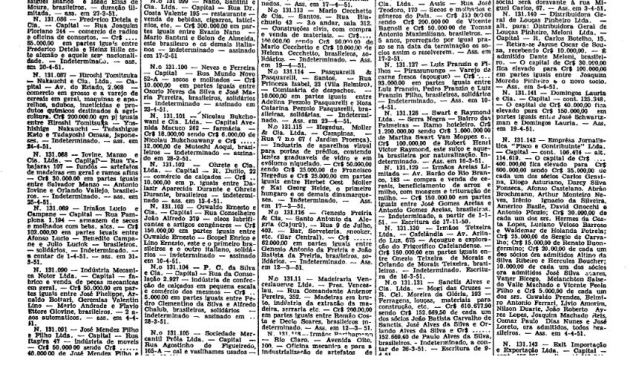 PDF File: Areias irmaos Diario oficial 24 -5-1951
PDF File: Areias irmaos Diario oficial 24 -5-1951
LETTERS FROM JORNALIST ALFREDO GOMES AREAS
TO MODERNIST WRITER MARIO DE ANDRADE
CARTAS DO JORNALISTA ALFREDO GOMES ARÊAS
PARA O ESCRITOR MODERNISTA MÁRIO DE ANDRADE
– Jornal Tribuna de São Carlos – Pró Memória – Pesquisadora encontra informações sobre as origens de sua família – 7/10/2007, Brasil.
Article featuring Juliana Areias about Tinos Family research and the first Tinos Family reunion in Brazil, in 2007.
Artigo com Juliana Areias sobre a pesquisa e primeiro encontro da Família Tinos no Brasil, em 2007.
Transcription / Transcrição (Jornal Tribuna de São Carlos – 7/10/2007, Brasil)
Pró Memória – Pesquisadora encontra informações sobre as origens de sua família
Ancestrais chegaram a São Carlos em 1885 – um encontro de parentes será realizado neste domingo em restaurante do distrito de Santa Eudóxia
Juliana Areias encontrou dados sobre o casamento de seis dos filhos de Antônio e Elisabetta.
Juliana Areias, paulistana de 32 anos, ouvia desde criança as recordações de seus avós lembrando histórias a respeito dos pais deles, contando que eram austríacos de Viena.
Juliana questionava os avós: então por que não falam alemão? E os avós respondiam que a família falava “furlan”. Isso deixava Juliana muito curiosa.
Essa curiosidade ficou latente a maior parte de sua vida. Aos 18 anos foi morar na Bahia, graduou-se em Belas Artes pela Universidade Federal e dedicou-se à música, iniciando uma carreira de cantora. Aos 21 anos foi para a Suíça, onde conheceu Rogério Teixeira da Mata, metalúrgico de São Bernardo do Campo que estava trabalhando lá. Casaram e vieram ao Brasil em 2000, quando ficaram sete meses viajando pelo país visitando os parentes das duas famílias. Foi nessa ocasião que aguçou sua curiosidade sobre as origens da sua família. Ela voltou a questionar a tia e a avó e soube que os ancestrais tinham vivido em São Carlos.
Nova Zelândia – Ainda em 2000, o casal seguiu para a Nova Zelândia, onde ela teve a sorte de engajar-se num projeto acadêmico, sobre samba, na escola de música da Universidade de Auckland. Trabalhou na instituição dois anos e continuou fazendo apresentações em bares, restaurantes, animando festas e casamentos e participando de alguns festivais de música. Mesmo tão longe do Brasil, a curiosidade continuava acesa e nas horas vagas buscava as respostas sobre as origens da família, pesquisando na internet e ingressando em grupos de discussão de genealogia.
O marido, depois de algum tempo como chefe de cozinha de um restaurante, obteve trabalho na sua profissão, ingressando numa empresa como torneiro mecânico. Em 2002 nasceu Jobim, o primeiro filho do casal. Para Juliana foi um “sinal” de que eles deveriam continuar morando por lá. Em 2005 nasceu Lilás. Os filhos representaram novo estímulo para buscar as origens. Ela conta que sentiu que, mais do que nunca, precisava conhecer a história dos ancestrais, “para deixar a meus filhos essa herança, a memória da família”.
Desenrolando o novelo –Não foi fácil desenrolar o fio do novelo com as pistas das origens da família, para achar as respostas que procurava. Escreveu muitas cartas para a Áustria, mas nunca recebeu uma resposta.
Ficou entusiasmada quando um primo, Felício Cabral Mendes, conseguiu localizar a chegada a Santos dos ancestrais no vapor “Maria”, em 16 de abril de 1885.
Depois, pela internet, num grupo e discussão sobre genealogia, contatou o historiador italiano Ugo Perissinotto, que ajudou bastante a desvendar as origens da família.
Foi localizando parentes e criou e mantém na internet um grupo que pode ser acessado no endereço https://br.groups.yahoo.com/groups/familiatinos/.
Antônio e Elizabetta – Juliana Areias afirma que, “ao que tudo indica, no Brasil, todos os ramos são descendentes de um mesmo tronco familiar:o casal Antônio Tinos e Elisabetta Grassetti Tinos (Isabel) e seus 8 filhos: Celestina, Luigi (Luiz), Maria (Anna Maria), Giuseppe (José), Caterina, Antônio, Marcelina (minha bisavó) e Eugênia”.
Ela acrescenta que “do Porto de Santos a família seguiu para São Carlos, onde eles trabalharam ao menos em duas fazendas, Boa Esperança e Santa Eudóxia. Descobri também que eles falavam realmente o edioma “furlan” e eram originários de Strassoldo, que na época pertencia à Província de Gorizia (Gorz) como território do Império Austro-Húngaro e hoje é parte da Itália, pertencendo à Comune Cervignano del Friuli, Província de Udine, Região Friuli Venezia Giulia.”
Na Pró-Memória – Agora de volta ao Brasil para uma temporada de quatro meses, Juliana e Rogério, trazendo Jobim e Lilás, vieram desta vez para apresentar as crianças aos familiares.
Na semana passada, de passagem por São Carlos, Juliana aproveitou para pesquisar no banco de dados de habilitações de casamento do Arquivo Público e Histórico da Cidade, da Fundação Pró-Memória, entidade vinculada à Prefeitura Municipal, no qual encontrou dados sobre o casamento de seis dos oito filhos de Antônio e Elisabetta Tinos. Ela comenta que, nos últimos anos, em contato com outros pesquisadores, especialmente graças a Sônia Trombelli, tem ouvido falar bem da instituição são-carlense, na qual diz ter sido muito bem atendida.
Ela conta ainda que, ao longo de sua pesquisa, achou parentes em vários estados brasileiros e também nos EUA. E revela que espera reunir cerca de setenta membros da parentela neste domingo (7), no Restaurante Dom Mineiro, em Santa Eudóxia, localidade escolhida para o encontro por ter sido um dos primeiros pontos de fixação da família no Brasil.
Translation – (Jornal Tribuna de São Carlos – 7/10/2007, Brasil)
“Pro Memoria” (Pro Memory) – Researcher finds information about the origins of her family
Ancestors arrived in São Carlos in 1885 – a family reunion will be held this Sunday in a restaurant in the district of Santa Eudoxia
Juliana Areias found data on the marriage of six of the children of Antonio and Elisabetta.
Juliana Areias, a 32-year-old from São Paulo, had listened to her grandparents remembering stories about their parents, telling them they were Austrians from Vienna.
Juliana questioned the grandparents: so why don’t they speak German? And the grandparents answered that the family spoke Furlan. That made Juliana very curious.
This curiosity stayed dormant for most of hes life. At the age of 18, she moved to Bahia, graduated in Fine Arts from the Federal University and dedicated herself to music, starting a singing career. At age 21 she went to Switzerland, where she met Rogério Teixeira da Mata, a turner-fitter from São Bernardo do Campo who was working there. They married and came to Brazil in 2000, when they spent seven months traveling around the country visiting relatives of the two families. It was on this occasion that she whetted hes curiosity about the origins of hes family. She again questioned her aunt and grandmother and learned that the ancestors had lived in Sao Carlos.
New Zealand – Also in 2000, the couple moved to New Zealand, where she was fortunate enough to work in an academic project on samba at the University of Auckland’s music school. She worked in the institution for two years and continued to perform as a singer in bars, restaurants, celebrations and weddings and participating in some music festivals. Even so far from Brazil, curiosity ticked on and her free time, she sought answers about the origins of the family, searching the internet and joining genealogy discussion groups.
Her husband, after some time as head chef of a restaurant, got a job in his profession, joining a company as a fitter-turner. In 2002 was born Jobim, the couple’s first child. For Juliana it was a “sign” that they should continue to live there. In 2005 Lilás was born. The children represented a new stimulus to seek her origins. She says she felt that more than ever she needed to know the history of their ancestors, “to give my children this inheritance, the family memory.”
Piecing together the puzzle -It was not easy to unfold the origins of the family and to find new clues and the right answers she wanted. She wrote many letters to Austria but never received an answer.
She felt enthusiartic when a cousin, Felício Cabral Mendes, managed to locate the arrival register of their ancestors in the steamship “Maria”, on April 16th, 1885.
Then, through the internet genealogy forums, she contacted the Italian historian Ugo Perissinotto, who helped a lot to unravel the origins of the family.
She has loccated relatives and created and maintained a group on the internet that can be accessed at https://br.groups.yahoo.com/groups/familiatinos/.
Antônio and Elizabetta – Juliana Areias affirms that, “it seems that in Brazil, all family branches are descended from the same couple Antônio Tinos and Elisabetta Grassetti Tinos (Isabel) and their 8 children: Celestina, Luigi (Luiz), Maria (Anna Maria), Giuseppe (José), Caterina, Antônio, Marcelina (my great-grandmother) and Eugênia.
She added that “from the port of Santos, the family went to São Carlos, where they worked on at least two farms, “Boa Esperança” and “Santa Eudoxia”. I also discovered that they really spoke Furlan, and that they were from Strassoldo, which at the time was part of the Province of Gorizia (Gorz) as a territory of the Austro-Hungarian Empire and today is part of Italy, belonging to the Comune Cervignano del Friuli, Province of Udine, Region Friuli Venezia Giulia.
In Pró-Memória (Pro-Memory) – Now returning to Brazil for a four-month stay, Juliana and Rogério, bringing Jobim and Lilás, came this time to introduce the children to their families.
Last week, when passing through São Carlos, Juliana took the opportunity to search the database of marriage qualifications of the Public and Historic Archive of the City, the Pro-Memory Foundation, which is linked to the City Council, in which she found data on the marriage of six of the eight children of Antonio and Elisabetta Tinos. She comments that in recent years, keeping contact with other researchers, especially thanks to Sonia Trombelli, she has heard a lot about this institution in São Carlos, in which she says she has been very well attended.
She also says that, throughout her research, she found relatives in several Brazilian states and also in the United States. She reveals that she expects to gather about seventy members of hes family this Sunday (7), at the Dom Mineiro Restaurant in Santa Eudoxia, chosen as the location for this family reunion because it was one of the family’s first fixation points in Brazil.
JULIANA AREIAS & GEOFFREY DRAKE-BROCKMAN
ARTS MEDIA – MÍDIA ARTÍSTICA
Juliana Areias: Wikipedia / Website / Youtube / Media
Geoffrey Drake-Brockman: Wikipedia / Website / Youtube / Media
MEDIA HIGHLIGHTS / DESTAQUES DE MÍDIA
 – Brazilian Magazine – REVISTA EPOCA – EDITORA GLOBO Google’s translation of the article / Online article Special thanks to jornalists Bruno Astuto, Acyr Mera Junior, Dani Barbi, Karla Rondon Prado, Claudia Jardim Rondon and Rodrigo Vasconcellos.
– Brazilian Magazine – REVISTA EPOCA – EDITORA GLOBO Google’s translation of the article / Online article Special thanks to jornalists Bruno Astuto, Acyr Mera Junior, Dani Barbi, Karla Rondon Prado, Claudia Jardim Rondon and Rodrigo Vasconcellos.
 – JORNAL O DIA – Rio de Janeiro Newspaper – Diversao – 8 March 2014 – Print and online articles by Ricardo Schott . Special thanks to journalists Ricardo Schott, Karla Rondon Prado, Claudia Jardim Rondon and Rodrigo Vasconcellos. Google translator
– JORNAL O DIA – Rio de Janeiro Newspaper – Diversao – 8 March 2014 – Print and online articles by Ricardo Schott . Special thanks to journalists Ricardo Schott, Karla Rondon Prado, Claudia Jardim Rondon and Rodrigo Vasconcellos. Google translator
– Review by Antonio Carlos Miguel from O Globo – Brazil on 7 February 2015 – about the song “Flecha” , a track of “Juliana Areias – Bossa Nova Baby” CD. Antonio Carlos Miguel, journalist specialized in music for over 35 year, author of the book “Guide of Brazilian Popular Music in CD” and judge member of the “Latin Grammy” and of the ” Brazilian Music Award” : – “It’s bossa that plays soccer with jazz – like it has since the 60’s – and scoring a goal.” – ” Por streaming, também fui apresentado ao primeiro single de “Bossa nova baby”, disco de estreia de uma brasileira radicada desde 2009 em Perth, na Austrália, Juliana Areias. É bossa que bate bola com o jazz, como vem acontecendo desde os anos 1960, e que acerta o alvo, como ouvi pelo Soundcloud na canção “Flecha” (de Juliana e Glenn Rogers), dedicada aos 450 anos que o Rio completará em março. Quando conhecer o CD completo, volto a ele.”
” Por streaming, também fui apresentado ao primeiro single de “Bossa nova baby”, disco de estreia de uma brasileira radicada desde 2009 em Perth, na Austrália, Juliana Areias. É bossa que bate bola com o jazz, como vem acontecendo desde os anos 1960, e que acerta o alvo, como ouvi pelo Soundcloud na canção “Flecha” (de Juliana e Glenn Rogers), dedicada aos 450 anos que o Rio completará em março. Quando conhecer o CD completo, volto a ele.”
– Review – O Globo by Antonio Carlos Miguel – 30 May 2015 – Antonio Carlos Miguel, journalist specialized in music for over 35 year, author of the book “Guide of Brazilian Popular Music in CD” and judge member of the “Latin Grammy” and of the ” Brazilian Music Award”.
“Também em versão digital, disponível em diversos serviços de streaming, conferi “Bossa nova baby”. É música brasileira produzida na remota cidade australiana de Perth, local onde vive desde 2009 a cantora e compositora paulistana Juliana Areias (Correção: ao ser publicado, este texto dizia que a cantora era carioca. A informação foi corrigida em 2 de junho).
A boa impressão deixada em fevereiro passado por seu primeiro single, “Flecha”, se confirma em muitas outras canções. Basicamente, sambas e bossas com um pé no jazz garantem o interesse, incluindo “Maré cheia” (esta é uma que, por exemplo, cairia bem demais na voz de Gal), “Última canção de um amor”, “Missão” e “Como vai”. Uma balada entre o tango e a milonga, “Dia a dia”, e um choro-canção, “Belas artes”, têm função mais introspectiva. Mas, abrindo demais leque, pouco acrescentam a toada sertaneja “Estrela acalanto” e o carimbó “Meu lugar”. De qualquer forma, mesmo com essas eventuais bolas fora, “Bossa nova baby” é surpresa de boa canção brasileira feita longe e ainda ignorada entre nós. Para quem estiver por perto, neste domingo (31/5), Juliana participa do Perth International Jazz Festival.”
(Translation) – ” I reviewed the “Bossa Nova Baby” album in its digital version as available via several streaming services. It is Brazilian music produced in the remote Australian city of Perth, where singer-songwriter Juliana Areias from São Paulo has lived since 2009.
The good impression left last February by her first single “Flecha” (Arrow) is confirmed by many other songs. Basically, the album consists of interesting sambas and bossas with one foot in the jazz world; including “Mare Cheia” (Full Tide) (this is a song that, for example, would be a good fit for Gal Costa’s voice), “Última canção de um amor” (Last song of a love), “Missão” (Mission) and “Como vai” (How are you). A ballad that sits between tango and milonga, “Dia a dia” (Day to Day), and a choro-canção, “Belas artes” (Fine Art), are more introspective. However, the toada sertaneja “Estrela acalanto” (Star lullaby) and the carimbó “Meu lugar” (My place), open the range too wide and add little to the album. Even with these possible off kicks, “Bossa Nova Baby” is a welcome surprise of good Brazilian music, made far away, and as yet unknown in Brazil. For those who are nearby, on Sunday (31/5), Juliana will be part of the Perth International Jazz Festival.
– Review – The Australian by Tony Hillier , 6 June 2015
” Back in Brazil, where she was raised and given the nickname Bossa Nova Baby, Juliana Areias has been compared to Bebel Gilberto, the genre’s golden girl. Now this Sao Paulo-born singer is the toast of Perth’s jazz scene. Areias cut her teeth on Corcovado and other Antonio Carlos Jobim classics, but the release of Bossa Nova Baby has elevated her above a mere covers singer or bossa specialist. Not that she has turned her back on her heritage. Her first album comprising all original compositions starts with Garoto de Copacabana, which tips a panama to The Girl from Ipanema, the song that helped introduce the suave samba-derived music to the world. While it’s a classy introduction, with cool flugelhorn and saxophone echoing Areias’s dulcet tones, it’s merely a harbinger of what’s to come in a set that features consummate accompaniment from the cream of West Australia’s Latin jazz instrumentalists. The singer excels in an elegant co-composed duet (Belas Artes) with Australia’s finest Brazilian-oriented 7-string guitarist, Doug de Vries. Four-stringed cavaquinho guitar and trombone help generate rhythm as Areias ups the ante in Ultima Cancao De Um Amor. In Flecha, the singer salutes samba and the Rio carnival, aided by a battery of percussion (pandeiro, surdo, cuica et al) and electric guitar. Alto flute helps create ambience in a quieter New Zealand-inspired bossa that’s delivered in English. Portuguese Guitarra and a guest choir respectively illuminate folkloric-styled pieces dedicated to northern and eastern Brazil.”
- West Australian – Today – Out & About at the WASAS by Emma Bergmeier-Varian. Juliana Areias & Geoffrey Drake-Brockman at the Western Australian Screen Awards Ceremony. Geoffrey, the artist creator of the Western Australian Screen Award Statuette – Sculpture. Photos by John Koh – 6 July 2016

- Newspaper JORNAL FOLHA DE SAO PAULO – Ilustrada – Fri 16 Dec 2016 by Victoria Azevedo, Brazil. ” Juliana Areias apresenta seu album de estreia com musicos da Jazz Sinfonica”.

- Newspaper Jornal O Globo – Segundo Carderno by Leonardo Lichote. – 28 Dec 2016 Rio de Janeiro, Brazil.

- Article newspaper Jornal Correio da Bahia – VIP: radicada na Australia, cantora se apresenta na JAM no MAM. By Gabriela Cruz, Giuliana Mancini e Verena Paranhos – 3 Jan 2017 – Salvador, Bahia, Brazil.

- Note newspaper Jornal A TARDE – 7 Jan 2017, Salvador, Bahia, Brazil.

- TV Live performance and interview at TV Record News- Programa Talentos do JRNews – reprise, best of the year – 28 Jan 2017 – 21h, Sao Paulo, Brazil.
 Radio Interview for Jovem Pan – 100.9FM – Sao Paulo, Brazil – Live on Friday 9 Dec 2016 – 4.30pm ( Sao Paulo Time). #radioatividade
Radio Interview for Jovem Pan – 100.9FM – Sao Paulo, Brazil – Live on Friday 9 Dec 2016 – 4.30pm ( Sao Paulo Time). #radioatividade
- 7th February 2015 – Bossa Nova Baby CD Launch – Juliana Areias 40th birthday
- – July 2014
 Edition
Edition  – TV CAMERA SP (Sao Paulo, Brazil)- Friday 28 March 2014 – Full broadcast interview for “Revista da Camera” by Fabrizio Gloria. Talking about Juliana Areias’ artistic trajectory, influences , family and the production of the first Original Album Bossa Nova Baby – (In Portuguese. 30 min).Part 1 –Part 2 –CNN’s GREAT BIG STORY
– TV CAMERA SP (Sao Paulo, Brazil)- Friday 28 March 2014 – Full broadcast interview for “Revista da Camera” by Fabrizio Gloria. Talking about Juliana Areias’ artistic trajectory, influences , family and the production of the first Original Album Bossa Nova Baby – (In Portuguese. 30 min).Part 1 –Part 2 –CNN’s GREAT BIG STORY
Art of the Future
Produced by Published: 3 November 2016

Art of the Future: These Interactive Sculptures Respond to You
Geoffrey Drake-Brockman makes cybernetic sculptures that appear to come alive with human interaction. Using his background as a computer programmer, this Australian artist makes work that moves, twists and even changes colors in response to a viewer’s movement. For Brockman, it’s this conversation between his art and the audience that makes his work special and engaging in a whole new way.
- TEDx PERTH
Created Beings
by GEOFFREY DRAKE-BROCKMAN
Published: December 2012
Geoffrey Drake-Brockman – Created Beings
TEDx Perth December 2012, Talk length: 14:53
Geoffrey Drake-Brockman – Robot Maker
Geoffrey is a Perth-based artist specialising in robotics, lasers, and optical interactive installations. Geoffrey studied Computer Science at The University of Western Australia before completing a master’s degree in Visual Arts at Curtin University. He has been exhibiting since 1986 with shows in Perth, Sydney, Melbourne, Canberra, Singapore, New York and London. His most recent solo exhibition was in 2010, when he installed his robotic work Floribots at the Singapore Art Museum.
Geoffrey has also shown work at the National Gallery of Australia and participated in the Helen Lempriere National Sculpture Award, The Biennale of Electronic Arts Perth and Sculpture by the Sea – in Bondi, Cottesloe, and Aarhus, Denmark. Geoffrey has completed a number of public art commissions including the laser-based work Transfiction (Canberra) and the robotic sculpture Totem at the new Perth Arena.
-
THE NEW YORK TIMES
Using Illumination to Truly See
By BENJAMIN GENOCCHIO
Published: 28 December 2003
ART REVIEW; Using Illumination to Truly See
ALTHOUGH mostly in the dark, ”The Luminous Image VI” at Collaborative Concepts here is all about light. Organized by Franc Palaia, the exhibition brings together two dozen national and international artists making photo-based artwork in which illumination is an integral element. Contributions range from light boxes and video projections to illuminated photo sculpture and window transparencies.

”The Luminous Image VI” is the sixth in a series of exhibitions of art using light organized by Mr. Palaia since 1996. (Bar one, in Italy, all these exhibitions were in galleries and museums in the United States.) This is by far the largest installment in the series, and with so many stylish inclusions I’m guessing it’s among the best.
So what have we got? First up, this is the kind of exhibition that encourages thoughtfulness. That means you’ve got to work a bit, to spend time with the artworks to understand what’s going on. If that seems like an imposition, and it is, sort of, then rest assured that most pieces repay patient viewing. Some you’ll even want to see again.
Nina Katchadourian’s video ”Endurance” (2002) is thoroughly captivating. It consists of an enlarged close-up of the artist’s open mouth, with one of her central teeth serving as a projection screen for film of Sir Ernest Shackleton’s doomed (1914-1916) Antarctic expedition – part of the film shows his ship being crushed by ice. The video lasts 10 minutes and the artist keeps her mouth open the entire time.
Ms. Katchadourian’s comfortless pose is an act of endurance. She is in pain, as witnessed by her contorted face and the repeated sounds of slurping on the video’s minimal soundtrack. Pools of saliva build at the edges of her mouth, eventually spilling over. We are meant to empathize with her stoicism, mirroring that of the explorers.
Equally enthralling is an installation by Richie Kuhaupt and Geoffrey Drake-Brockman. ”Essentialiser” (2003) consists of a darkened wooden cube crisscrossed with lasers arranged in a grid, meaning that anything in the cube is embedded in a matrix of little cubes of red light. Activity inside the cube is monitored by an infrared camera, and then displayed inside and out as a laser-generated model on feedback monitors. It’s all very complicated.
Mr. Kuhaupt’s and Mr. Drake-Brockman’s futuristic installation is perhaps the freakiest work in the exhibition. I say that not for what it is, but for what it represents. Here, the body is mapped and then reduced to bare geometrical data. It is the electrical equivalent of cloning, with the laser beams transforming people into coded information and then creating virtual replicas. Is that scary? I think so, or maybe I’ve been watching too many sci-fi films.
Projection and visual reproduction are also central to Debra Pearlman’s installations. Of the artist’s three works in the exhibition, the best is ”Sleep” (1990), a sandblasted image in glass set into a tabletop placed above a mound of sand. When light is shined through the glass, the shadow of two children appears on the sand. It is a subtle, clever work.
Peter Sarkisian is perhaps the best-known artist in the exhibition. His ”Book Series #28” (1997) uses a video monitor concealed in a pile of books beneath a magnifying glass. The video image, visible through the magnifying glass, matches the missing section of the image on the cover of the book, in this case a classical painting of a naked woman. Every now and then, the woman’s hand moves between her thigh and mid section. It’s creepy.
Various kinds of light boxes (popular these days with artists to display photographs) can be found in the exhibition. Examples include David Michalek’s photographs of homeless people, Elizabeth Cohen’s and Michael Talley’s X-ray photographs, Greg Geffner’s 3-D stereoscopic light prints, Kristin Anderson’s digital portraits with moving text, Kiki Seror’s X-rated cyber sex stories. All are clever, engaging, and well made.
Sensual and lonesome, Shimon Attie’s projection photographs kept drawing me back. One of them, ”Untitled Memories” (1998) shows a prosaic apartment scene into which a reclining male figure has been projected. He is lying on a bed, drinking beer and watching television — his fuzzy reflection all that can be seen on the television screen. It’s an unsettling image, one that gets more and more intriguing the longer you look.
Finally, John Kalymnios deserves mention. At first, his light box images of clouds appear fairly unremarkable. Look closer and you’ll see the surface is actually a piece of carved Corian plastic. The Corian has been expertly carved using a fine laser directed by a computer, with each image requiring hours of work. Without doubt, these works are among the most poetically beautiful and technically ingenious in the exhibition. And that is saying something.
”The Luminous Image VI” is at Collaborative Concepts, 348 Main Street, Beacon, through Feb. 2. Information: (845) 838-1516.
Photos: ”Married by Dusk, Killed by Dawn (one thousand and one nights)” by Kiki Seror, left, is part of an exhibition of artworks using light at Collaborative Concepts. ”Essentialiser,” top right, is a futuristic installation by Geoffrey Drake-Brockman and Richie Kuhaupt. Below right: ”Untitled Cloudscape #1 & #3,” part of a series by John Kalymnios.
-
- THE WEST AUSTRALIAN
Totem Tribute to Robotics
by STEPHEN BEVIS
Published: 5 November 2012
Totem Tribute to Robotics
The Perth Pineapple, Corn Cob or Banksia Cone, call it what you like, Geoffrey Drake-Brockman’s Totem draws on sophisticated robotics and schoolyard origami to make a memorable piece of public art.
“I think that it is grI think that it is great that it has its own nickname,” Drake-Brockman says of his 10.5m installation outside the Perth Arena which is already engaged in a Twitter duel with the green James Angus sculpture in Forrest Place dubbed the Perth Cactus. “As an artist, you want your work to enter the public consciousness.”
Six years in the making, Totem is a dramatic monument of 108 yellow-and-purple aluminium triangles. A towering high-tech version of the playground paper-craft game chatterbox, its moving panels are programmed to open and close like flower petals in response to people walking past.
Operating to a complex computer program, Totem had a mind of its own and the “petals” could form hundreds of thousands of unpredictable configurations, Drake-Brockman said. “Once the algorithms have been written, it is set free and then it responds to its own environment,” he said. “It has its own sensors and is able to tell what is going on around it and then it does what it wants to do.”
To cap it off, Totem also shoots geometric laser projections onto the wall of the Arena at night.
The Dalkeith artist has used the chatterbox idea in a previous artwork called Floribots, a collection of 128 potted, robotic flowers equipped with motion sensors.
Born in the 1960s rocket research hub of Woomera, Drake-Brockman has fused the exploratory wonderment of science and art since abandoning a full-time career as an IT professional in the 1990s.
“I always thought science and art were endeavours which were self-justifying; they didn’t need to be justified in terms of anything else or any particular benefits they would bring. I thought they were sources of beauty and absolute knowledge, I guess.”
His artworks include several laser installations, the Coppelia Project series of robotic ballerinas modelled on WA Ballet star Jayne Smeulders, and a big yellow walk-through counting machine at Sculpture by the Sea in 2010.
Though high in technology (a bank of computers sit in its “head”), Totem required relatively low maintenance and ought to be resistant to “excessively vigorous interaction with the public”, Drake-Brockman said.
“The way it develops will be influenced by the people who engage with it if it is to act as a totem, as a marker of a spot, an attractor of people. If people say, ‘Let’s meet at the Totem or the Big Pineapple’, I don’t mind. “The idea of a totem is somehow to reflect to a society something of itself back.
“That is my ambition for it – we will see how it works out.”
-
THE WEST AUSTRALIAN
Coppelia Salon
by DI BAUWENS
Published: 11 May 2013
Coppelia Salon

- – The West Australian – Today – Out & About – Wednesday 24 July 2013 -Perth Institute of Contemporary Art’s – PICA Salon 2013 – featuring the “Little Counter”- interactive sculpture by Geoffrey Drake-Brockman – beside Juliana Areias at the article.

-
THE SYDNEY MORNING HERALD
Record-breaking numbers and heights at Sculpture by the Sea
by LUCY CORMACK
Published: 24 October 2014
Record-breaking numbers and heights at Sculpture by the Sea

As the 2014 Sculpture by the Sea exhibition celebrates the 1000th artist to have featured in the event, one exhibiting artist is hoping to set a record of his own. He just needs the help of exhibition goers to pass through the arch of his artwork 999,999,999 times.
Geoffrey Drake-Brockman’s Counter does exactly what it says on the box. Each time someone walks through its infrared beam, the solar-powered counter goes up by one. Now showing for the fourth time in its fourth location across the world, he is hoping to well and truly pass the record of 288,601 in Aarhus, Denmark, to one less than a billion, whereupon it will tick back to zero.
“The positive is to participate in the social order, to stand up and be counted, to make your life count. The negative is just to be reduced by a machine to a number in the database. People can make the choice to be counted or not.” Counter is just one of 109 sculptures from 16 countries now perched along the coast from Tamarama to Bondi for the 18th annual Sculpture by the Sea.
Image: Geoffrey Drake-Brockman: one in 999,999,999. Photo: by Steven Siewert
THE WEST AUSTRALIAN
Through the looking glass
by WILLIAM YEOMAN
Published: 30 April 2016

Through the looking glass
Few people in Perth will be Few people in Perth will be ignorant of artist Geoffrey Drake-Brockman’s imposing yet playful public art, kinetic or otherwise. One has only to think of Perth Arena’s yellow and purple Totem, lovingly dubbed Perth’s own “Pineapple”. Or his Solar Jayne, a life-sized robotic sculpture modelled after WA Ballet’s Jayne Smeulders and part of Cottesloe’s Sculpture by the Sea 2014.
But how many have seen Drake-Brockman’s futuristic, technology-driven work as a prime example of Shakespeare’s idea of art holding a mirror up to nature? Now, in his first commercial exhibition in over a decade, the man who initially studied computer science because he believed art couldn’t be taught (he soon saw the error of his ways and attended art school) presents Looking Glass, a major survey of Drake-Brockman’s work across multiple media including sculpture, painting and installation.
“Having a a gallery exhibition like this allows me to put the full continuum of my practice on show, and hopefully create some links that people can see between the public art and the studio art, Drake-Brockman says.
Among the works on display is a spectacular new series of circular, square and triangular Portals which incorporate mirrors while echoing the art of hard-edge abstraction. “A looking glass is an archaic name for a mirror,” Drake-Brockman says. “The ‘paintings’ are mirrors. Yes, art is automatically a mirror. But putting a real mirror in there forces the issue. It implicates the viewer directly and quotes them back to themselves, if you will.” Perfect for the age of the selfie, one might say.
The exhibition’s title also recalls Lewis Carroll’s Alice Through the Looking Glass. But the connotations are more complex than that. “Mirrors do lots of wonderful things,” Brockman says. “They can be portals to different realities, like the one Alice passes through. They can recall a futuristic super-technology world and the super-reflective chromium surfaces you always see in science-fiction movies.”
Technology, of course, is another main theme in Drake-Brockman’s work. “I’m intensley interested in technology and it’s always woven into my work, either literally in terms of electronics or conceptually in terms of the direction that the work suggests,” he says. Given the swift changes in science and technology over the decades Drake-Brockman has been making art, it seems natural to assume his work would have evolved with it. That, however, inverts the reality, much as a mirror can.
“The evolution of technology doesn’t necessarily change the conceptual space because that can be in advance of what’s currently technologically possible,” Drake Brockman explains. “Just think of science fiction authors such as Arthur C. Clarke, who predicted geostationary sattelites long before they became a reality. Certainly, advancing technologies are very noticeable when you’re going about implementing a particular technological trick. Things which were once difficult and expensive to achieve become cheap and easy. “But the conceptual range of possibilities doesn’t change.”
And what of the different possibilities afforded by public art? “All my works are thematically linked,” Drake-Brockman says. “What the public art does is provide an opportunity to realise those themes on a larger scale. It also provides a large audience.”
Different again is the kind of audience one gets by exhibiting in Sculpture by the Sea. “You put a sculpture in front of 100, 000 people, right in the middle of their domain: that’s non-public art with high visibility,” he says. “Basically, the more people interact with my work, the more value I get out of watching it and seeing the possibilities.”
Looking Glass runs at Linton & Kay Galleries, 137 St Georges Terrace, from Monday-May 22. Picture: Iain Gillespie
PERTH NOW – SUNDAY TIMES
Geoffrey Drake-Brockman reflects on Looking Glass at Linton and Kay
by TANYA MACNAUGHTON
Published: 6 May 2016
Geoffrey Drake-Brockman reflects on Looking Glass at Linton and Kay
MANY will be familiar with Geoffrey Drake-Brockman’s work without necessarily knowing his name.
Totem, or what has affectionately become known as ‘the pineapple’ to those visiting Perth Arena, is one of several public art commissions by the Perth artist. After spending his youth in Canberra, an 18-year-old Drake-Brockman embarked on an eight-month hitchhiking tour of Australia that finished when visiting family in WA and he decided to stay.
“I started studying at UWA, initially physics but that turned into a computer science degree,” he said.
“For a long time I made the deliberate decision not to use technology in my art; I resisted using it until years later when I went to art school at Curtin University and did a Masters in visual arts, where I studied art theory.
“It led me to think about how the concept of technology could be interesting in visual art and having engaged with the concept, the logical next step was to use it.”
Drake-Brockman,who has an industrial warehouse studio in Nedlands, said he then found himself in a catch 22 with his ambition to secure large public art commissions using robotic and optical technologies.
“You can’t get a public art commission until you’ve already done a public art commission, so that seemed like an impenetrable closed shop at first” he said.
“I was working with another artist called Richie Kuhaupt and we came up with a proposal for a commission initially where I grew up in Canberra.
“That was my first public art commission and once you have one, it’s easier to get another.”
Drake-Brockman has since created Totem, the ascending Spiral at WA Police Headquarters and interactive light sculpture Luminous at Chinatown in Northbridge, plus works for Sculpture by the Sea, including Solar Jayne, inspired by WA Ballet principal dancer Jayne Smeulders. His latest foray finds Drake-Brockman stepping back into a commercial gallery with exhibition Looking Glass, something he has not done in 19 years.
“Public art commissions have kept me busy and supplementing that was institutional exhibitions at PICA or the National Gallery of Australia,” he said.
“I just thought it would be nice to go back to an old idea I hadn’t tried for a long time.
“There are about 30 works with static sculptures, interactive installation and 12 new paintings that I’ve just completed in the last few weeks; it’s the first time I’ve made paintings in about 20 years.”
The paintings have a strong geometric theme incorporating mirrors, flat surfaces and colour, and have been described by Drake-Brockman’s partner and Brazilian singer-songwriter Juliana Areias as “multi- dimensional paintings”. Areias sang her original song Belas Artes, meaning ‘Fine Arts’ in Portuguese and composed about Drake-Brockman, during the exhibition’s opening this week at Linton and Kay Galleries Perth, Level 1/137 St Georges Terrace. Looking Glass exhibition is showing until May 22.
Photo – Artist Geoffrey Drake-Brockman at Linton ans Kay gallery. Photographer: Andrew Ritchie
- Song “Fine Arts”, (canção Belas Artes) – by (de) Doug de Vries & Juliana Areias – for (para) Geoffrey Drake-Brockman.
BELAS ARTES (Fine Arts)
(Doug de Vries / Juliana Areias)
Para o Meu Amor (For My Love) Geoffrey Francis Drake-Brockman
A1
sobre as ondas do mar
paira o olhar do meu amor
até chegar, até pousar no meu
e me encantar, me desvendar, me namorar
bela nova é amar , ah!
e me encontrar no fundo do seu olhar
que tem o dom de transformar o que vê
bailarina a girar
em espirais e origamis,
pétalas ou diamantes
que se abrem pelo ar, vão pelo ar…
e me deixo contar
linhas e luz, curvas e sombras
a mão esboça, o corpo brilha
e se extasia de alegria com você
tanta história e vem
de antes de, em si, se encontrar
árvore e banco no mesmo lugar
divagar, respirar e sentir a paisagem
silhueta, capela ao mar
rubro amuleto
pulsar do peito
milagre feito de amor
inconvencional
bel sabor surreal
filmes, romance renascente em tal ritual
tudo em um, sobre a pele em contrastes
de Afrodite, petite mort
Joana D’arc
beija Da Vinci
tableaux vivants d’amour
on the waves of the sea
hovers the gaze of my love
until coming to, until landing on me
and charming me, unravelling me, courting me
beautiful news is to love, Ah!
and encounter myself at the bottom of your eyes
that have the gift of transforming what they see
ballerina spinning
in spirals and origamis,
petals or diamonds
that open in the air, flying through the air…
and let myself be counted
lines and light, curves and shade
the hand draws, the body shines
in ecstasy of joy with you
so much history and begins
before our first encounter
tree and bench in one place
meander, breathe and feel the landscape
silhouette, chapel of the sea
red amulet
pulsating breast
miracle made of love
unconventional
belle savour surreal
films, romance renascent in such ritual
all in one, on the skin in contrasts
of Aphrodite, petite mort
Joan of Arc
kisses Da Vinci
tableaux vivants of love
Blame it on the bossa nova tonight with Brazilian rhythms at the Bickford in Morristown
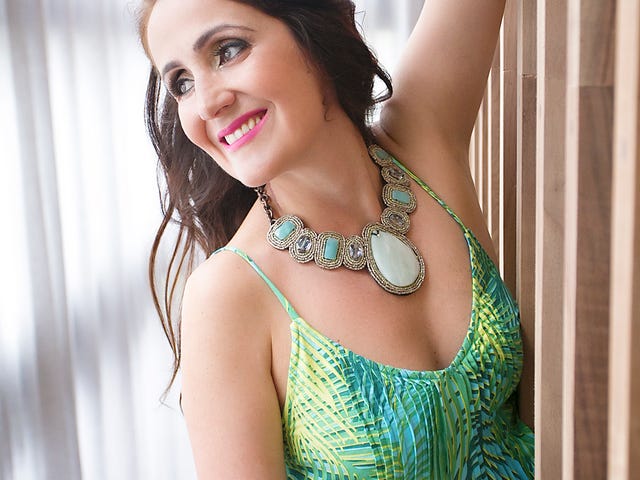
Thanks to her guitarist father, Areias was exposed to bossa nova, samba, and other vintage Brazilian rhythms. She also met leading musicians, such as Roberto Menescal and Ronaldo Boscoli, as well as music journalist Ruy Castro.
Castro was so impressed that a teen would enjoy a musical style that was 30 years old that he gave young Juliana a nickname: “Bossa Nova Baby.”
Now a singer-songwriter, Areias used that sobriquet as the title of her debut CD, released in 2015. As part of her current tour, Areias and her band will make their New Jersey debut at the Bickford Theatre at the Morris Museum on Friday, June 15.
Though the 12 songs on “Bossa Nova Baby” form the core of her set list, Areias sees her concert as a mini-history of the bossa nova and an indication of its future.
“We’re celebrating 60 years of this music,” said Areias. She noted that the first bossa nova hit in Brazil was “Chega de Saudade” (“No More Blues”), released in 1958.
She credited three Brazilians for creating the bossa nova style: guitarist Joao Gilberto, modernist poet Vinicius De Moraes, and composer Antonio Carlos Jobim.
“You had post-World War II jazz mixing with the samba, and that created the bossa nova,” Areias said. “Jobim would also say there was a classical influence, too.”
Compared to some other Brazilian styles, bossa nova is thus relatively recent. Areias said that several of the original composers – including her friend Roberto Menescal, Carlos Lyra, Marcos Valle, and Joao Donato – are still active.
The upbeat rhythms and optimistic lyrics of bossa nova found an audience in the U.S. in the late 1950s and early 1960s. Songs such as Jobim’s “The Girl from Ipanema” became staples for jazz artists and adult pop vocalists.
But Areias stressed that her approach to bossa nova is not restricted to the past. “Bossa nova is still evolving and mixing with other styles of music,” she said. “We want to show how bossa nova sounds now, in 2018.”
Areias’ own songs reflect such influence as funk and pop. She also draws on the tango, the samba, and the choro (a Brazilian style that even pre-dates the samba).
In concert, Areias and her band play new arrangements of bossa nova standards, besides her own songs. Her version of “The Girl from Ipanema” was strongly influenced by the late guitarist Raphael Rabello, who added a flamenco beat to the song.
Areias also performs versions of “Rio” and “O Barquinho” (“Little Boat”), co-written by Menescal. “We play classics, and some that aren’t as well known,” she said.
The idea of mixing styles and cultures is reflected in Areias’ life and her music. When she was 21, she left her native Brazil and moved to Switzerland. For a time, she lived in New Zealand before settling in Perth, Australia, where she lives.
Though Down Under may not seem like a hotbed for Brazilian music, Areias said she feels at home living and working in Perth.
She pointed out that the city has a thriving cultural life as the home to the University of Western Australia. At the same time, Perth is hours away from other large cities by plane.
“The isolation gives the freedom of creation,” Areias said. “Instead of just absorbing influences from the whole world, we develop our own roots, mixtures, and experiments to present to the world.”
Areias said she hopes her music allows audiences to understand those mixtures and experiments. “Our music is engaging and happy,” she said. “I want to take people on a journey with us.”
IF YOU GO:
JULIANA AREIAS
WHAT: A native of Brazil who has lived in Europe and Australia, singer-songwriter Areias specializes in such rhythms as the bossa nova and the samba. She and her band perform, in addition to her own material, original arrangements of such Brazilian composers as Antonio Carlos Jobim.
WHEN: 8 p.m. Friday, June 15
WHERE: Bickford Theatre at the Morris Museum, 6 Normandy Heights Rd., Morristown.
TICKETS: $18 for Museum members in advance, $20 for nonmembers.
INFORMATION: 973-971-3706 or http://www.morrismuseum.org.
STORY HIGHLIGHTS:
Juliana Areias will perform Friday, June 15, at the Bickford Museum at the Morris Museum.
Born in Sao Paulo, Areias writes and sings original songs utilizing the Brazilian rhythms of the bossa nova and the samba.
Besides songs from her CD, “Bossa Nova Baby,” Areias and her band perform original arrangements of Brazilian favorites such as “Mas Que Nada” and “The Girl from Ipanema.” 

Juliana Areias Jazzes Up The Green Room 42 with BOSSA NOVA BABY

Australian-based Brazilian singer-songwriter Juliana Areias wraps up her first U.S. Tour on Friday, June 29, with a salute to 60 years of the bossa nova at The Green Room 42, an upscale cabaret club serving New York City’s theater district. Drawing on traditional Brazilian bossa nova rhythms, Ms. Areias performs a distinctive style of Latin Jazz which has made her a hit down under. She will be joined by a Brazilian jazz ensemble which includes Oriente Lopez on piano, Jorge Continentino on flute and sax, Itaiguara Brandão on bass, and Samuel Martinelle on drums. Her show highlights a blend of original songs from her internationally acclaimed “Bossa Nova Baby” CD plus a selection of exclusive arrangements of bossa classics and samba hits.
Born and raised in Brazil, Juliana Areias began her music career in Europe before moving to Australia. It was her all original CD “Bossa Nova Baby” that catapulted her to fame less than two years ago. Featured on Australia Day 2016, the CD received multiple music award nominations and earned regular air play around the world. Her Bossa Nova Baby Show is filled with original tunes as well as classics such as “The Girl from Ipanema” and “Mas Que Nada,” blending jazz, pop, funk, ballad, and tango, all drawing on infectious samba rhythms.
Ms. Areias has performed at many major venues around the world including the famous Ronnie Scott’s Jazz Club in London, the Montreux Jazz Festival in Switzerland, the Auckland Festival in New Zealand, The Sydney Opera House in Australia and Beco des Garrafas, the legendary jazz club in Rio de Janeiro. Her first U.S. tour which began in Florida and ends in New York City marks the launch of her “Bossa Nova Baby” CD in America. In mid-June, she performed at New Jersey’s popular Bickford Theatre to an enthusiastic audience of bossa nova fans.
“I’m looking forward to appearing at New York City’s Green Room 42 with such a talented group of musicians,” said Juliana Areias. “Bossa Nova is my essence as a person, my original impulse as a singer and my life-soul-heart’s pulsation and it is an honor to share it with audiences around the world. Touring the United States has been a thrill and it has touched my heart to see my fans have as much fun as I do at each show.”
Joining Ms. Areias for the finale of her U.S. tour will be a talented ensemble of jazz musicians. Multiple Grammy-winning pianist Oriente Lopez came to New York from his native Cuba in 1993 and has collaborated with many artists including Paul Simon, Regina Carter, and Paquito D’Rivera. Jorge Continentino was born in Rio de Janeiro where he studied flute and saxophone. Since moving to New York 15 years ago, he has become best known for his collaborative Latin music group Forro in the Dark. The Brazilian bassist Itaiguara Brandao is a graduate of the Berklee College of Music and has become one of the most sought-after Latin and World Music artists, touring and recording with musicians such as Romero Lubambo, Robin Eubanks, and Paquito D’Rivera. And drummer Samuel Martinelli has worked with many top jazz musicians including Claudio Roditi, Alcione, Hendrik Meurkens, Nilson Matta, and Marcus McLaurine.
Juliana Areias, Bossa Nova Baby will appear at The Green Room 42 inside Yotel, NYC on Friday, June 29, at 9:30 p.m. Tickets are from $20 to $50 and there is no food or beverage minimum. With an extensive menu and bar, the entertainment venue has been embraced by theater fans and regularly brings in top talent. The Green Room 42 is located at 570 Tenth Avenue and 42nd Street on the 4th Floor inside YOTEL. Call 646-449-7792 for more information or go to www.onfournyc.com/tickets.html to reserve tickets.


- Article at World Jazz News – Jazz News with a Global Perspective USA/AUSTRALIA – Australian Performer Juliana Areias in NYC – NYC, USA, 25 June 2018.



- Article at Jazz News – Australian Performer Juliana Areias to Appear at NYC’s The Green Room 42 June 29th – Nestor Miniskby, NYC, USA. June 2018.
- Article at World Jazz News – Jazz News with a Global Perspective USA/AUSTRALIA – Australian Performer Juliana Areias in NYC – NYC, USA, 25 June 2018.
- Note at The West Australian newspaper, Weekend Arts, ArteFacts – Singer-Songwriter Juliana Areias – Samba to bossa nova tribute – Perth, Australia, 28 July 2018.

- Article at the Post newspaper, Time Out , “Us acclaim for Nedlands couple” by Sarah McNeill – Perth , Australia 28 July 2018


- The West Australian Weekend Newspaper note about Juliana Areias – Oceano Concert – 19-21Oct 2018, Perth, Australia.
- Article and interview with Juliana Areias – 60 years of Bossa Nova and first Japan Tour 2018 at Japanese Jornal Cordel Magazine – 7 Sept 2018 Tokyo, Japan.
名古屋でボサノヴァ60周年企画&ジュリアナ・アレイアスインタビュー

- IPC DIGITAL – Japan – articles ” Juliana Areias Launch album and her Debut concert in Japan” / Enjoy Focus Brasil Free Concerts – 3 September 2018, Japan.
